

Japan Sightseeing Map
- Flights and Airports
- Accommodation
- Transportation
- Internet & Phones
- Budget and money
- Japanese Food
- Visit with Kids
- Seasons: spring / summer / autumn / winter
- Weather forecast
- Time in Japan
- Holidays & Festivals
- Natural Disasters
- Customs and Duties
- Works and Closures
- From July 1 to 31 -- Gion Matsuri Festival in Kyoto with float processions on July 17 and 24
- July 1 -- Season start for climbing Mount Fuji
- July 15 -- Sea day / Umi no Hi in Japan (holiday)
- July 17 -- Tokyo Day
- July 19 -- End of rainy season (Tsuyu) in Japan
- From July 24 to 25 -- Tenjin Matsuri Festival in Osaka
- Tokyo : Shinjuku , Shibuya , Harajuku , Asakusa , Akihabara , Odaiba , Ikebukuro , Ueno , Roppongi , Chiyoda , Ryogoku ...
- Around Tokyo: Kamakura , Nikko , Hakone , Mount Fuji , Mount Takao , Yokohama ...
- Kansai: Kyoto , Nara , Osaka , Mount Koya , Himeji , Kobe , Kinosaki , Kumano Kodo , Ise ...
- Japanese Alps: Kanazawa , Matsumoto , Takayama , Shirakawa-go , Nakasendo ...
- West: Hiroshima , Miyajima , Shikoku , Onomichi , Naoshima , Izumo , Kurashiki , Matsue ...
- South: Kyushu , Okinawa , Yakushima ...
- North: Hokkaido , Tohoku ...

- Temples and Shrines
- Gardens and Parks
- Hiking and Trekking
- Observation Decks
- Public Baths (Onsen and Sento)
- Festivals (Matsuri)
- Amusement Parks
- Visit on a Budget / Luxury

Keikaku is a travel agency specialist of Japan and providing different kind of services:
- Japan Rail Pass
- English speaking Guides
- Pocket Wi-fi
- Japan Nightlife
- Working in Japan
- Religion and Spirituality
- Arts and History
- Movies / Animated Movies
- Japanese Music
- Studio Ghibli
- Photos / Videos
- Weird Japan
- Translations
- Kana & Kanji
- Japanese Swear Words
- Honorific Suffixes (san, kun, chan...)
- Introducing yourself
- Thank you / Apologize
- Count / Say Your Age
- Say the Date / Tell the Time
- Happy birthday
- Enjoy Your Meal
- Writing your name

Kanas are the much-needed basic characters of written Japanese language. Memorize them at a fast pace with our method.

Ask any kind of question and share your knowledge about Japan in Kanpai’s community space, our Q&A section Kotaete.

Isshoni means "together" in Japanese: share your trip details (dates, places you would like to visit) and find companions to travel in Japan.

Create your Kanpai account to manage your profile and view your participation history (questions, answers).
- TheTraveler .net
- Maps of Japan
Our tourist maps
The capital of Japan is a must-go to discover the many different aspects of the country. From the trendy boutiques of the Shibuya district to the video games and electronic stores in the Akihabara district, to the calming and relaxing Shinjuku Gyoen National Garden, each district has its own unique atmosphere. Kyoto, the former capital of the country, offers a calmer atmosphere. In the spring, a stroll along the Philosopher’s walk is a great opportunity to admire the blooming cherry trees. The city is also famous for its Zen temples and gardens. Visitors will be taken on a journey through history by a visit of Himeji Castle and of the Peace Memorial Museum in Hiroshima. In the Land of the Rising Sun, there is no need to look for adrenaline in order to enjoy your trip, people mainly come here to relax and recharge their batteries. Climbing Mount Fuji is one of the few activities for athletes. You should leave very early in the morning to admire the sunrise from the top, a breathtaking spectacle. Sports enthusiasts will also love the parks in Hokkaido that are ideal for hiking. In the north of Honshu Island, a small cruise in Matsushima Bay is very relaxing. A trip to Japan won't leave you indifferent.
Between skyscrapers in Tokyo, Osaka or Kyoto and the zen gardens of Buddhist temples, Japan evokes contrasting images. The country shines with its cultural richness, the result of a turbulent and enigmatic past, but also thanks to its breathtaking landscapes! The seaside resorts and spa resorts won't disappoint you and offer a relaxing stay. Finally, Japan is also a land of traditions with ancestral culture and gastronomy, a land with its own typical festivities.
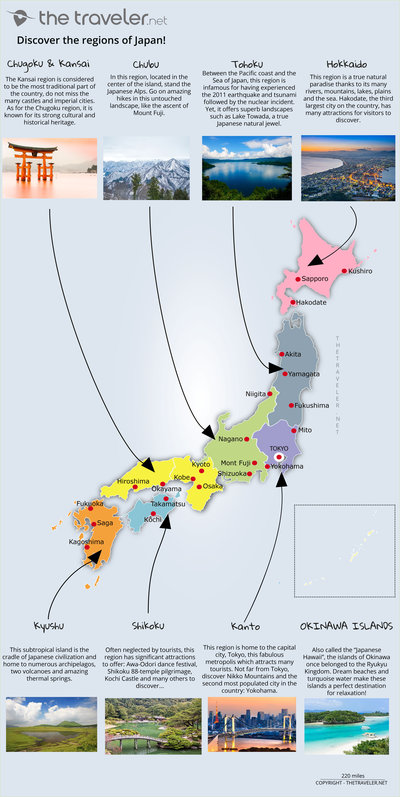
Overview of 8 tourist regions
In this region, located in the centre of the island, stand the Japanese Alps. Go on amazing hikes in this untouched landscape, like the ascent of Mount Fuji.
Chugoku & Kansai
The Kansai region is considered to be the most traditional part of the country, don't miss out on the many castles and imperial cities. As for the Chugoku region, it is well known for its strong cultural and historical heritage.
This region is a true natural paradise thanks to its many rivers, mountains, lakes, plains and the sea. Hakodate, the third largest city on the country, has many attractions for visitors to discover.
This region is home to the capital city, Tokyo, this fabulous metropolis which attracts many tourists. Not far from Tokyo, discover the Nikko Mountains and the second most populated city in the country: Yokohama.
This subtropical island is the cradle of Japanese civilization and home to numerous archipelagos, two volcanoes and amazing thermal springs.
OKINAWA ISLANDS
Also called the “Japanese Hawaii”, the islands of Okinawa once belonged to the Ryukyu Kingdom. Dream beaches and turquoise water make these islands a perfect destination for relaxation!
Often neglected by tourists, this region has quite a lot of attractions to offer: Awa-Odori dance festival, Shikoku 88-temple pilgrimage, Kochi Castle and many others to discover...
Between the Pacific coast and the Sea of Japan, this region is sadly known for having experienced the 2011 earthquake and tsunami followed by the nuclear incident. Yet, it offers superb landscapes such as Lake Towada, a true Japanese natural jewel.
Attractions maps
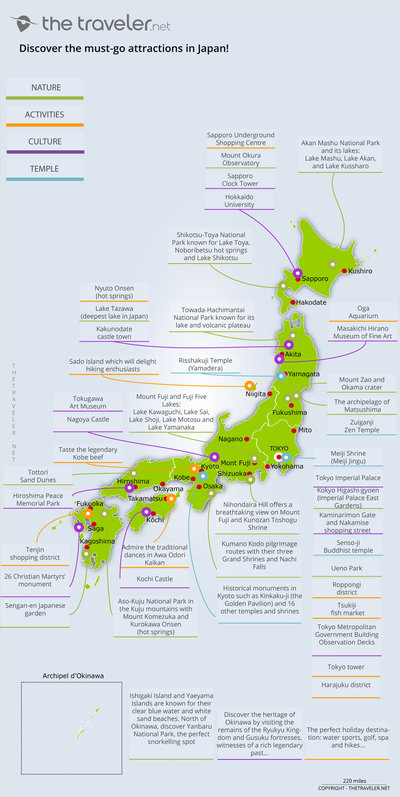
Routes and distances maps
CULT Travelling inside the country can be quite expensive, however, Japan has one of the best railway networks in the world, so opt for the Japan Rail Pass which allows you to save money by not buying a train ticket for each journey. Domestic flights can also be a good option, there is a special package for tourists: the Star Alliance Japan Airpass which allows up to five domestic flights and a lot of money saving. Finally, Japan is an island nation, and the many islands are connected by ferry services.
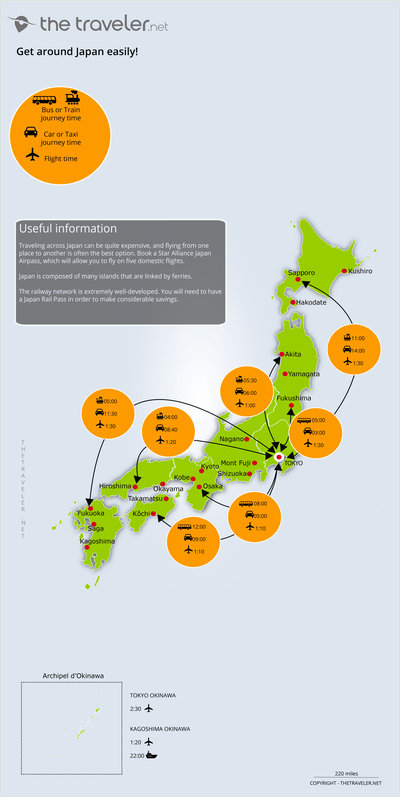
Let's Go! A Summary of Popular Japanese Food and Condiments Part 4: Basic Condiments (Sauces, Herbs, Flavorings)
Japan | Japanese Cuisine

Let’s go! A Summary of Popular Japanese Food and Condiments Part 3 (Donburi and Yoshoku)
Japan | Food & Drink

Let's go! A Summary of Popular Japanese Food and Condiments Part 2 (Hotpots and Hotplates)
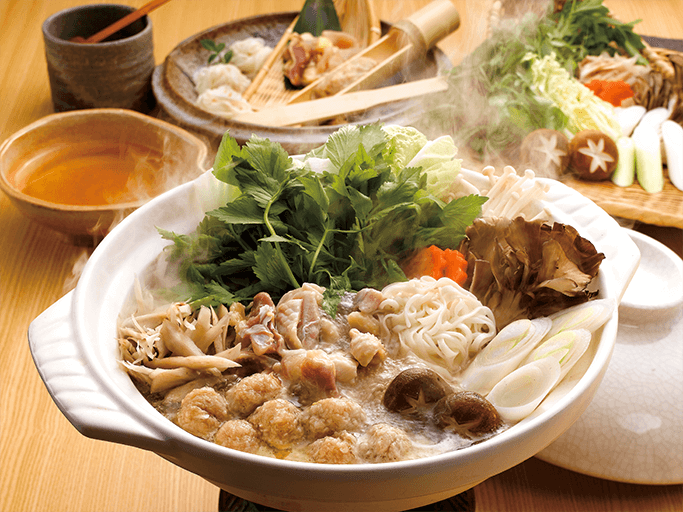
Starbucks Reserve® Roastery Tokyo: A Coffee Experience Beyond Your Wildest Beans
Japan | Traveling

Biking Adventure in Tsuchiura, Ibaraki: Enjoy the Food, History, and Scenery
Ibaraki | Historical Landscapes

- EDITOR'S CHOICE -
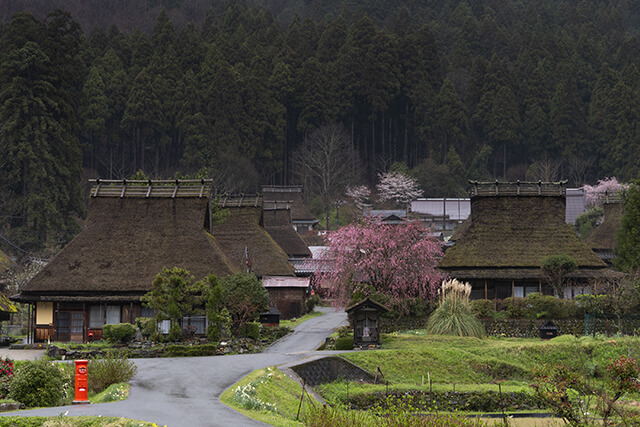
Japan | Ryokan Inns
Where to stay in Miyama, Kyoto’s thatched-roof farmhouse village
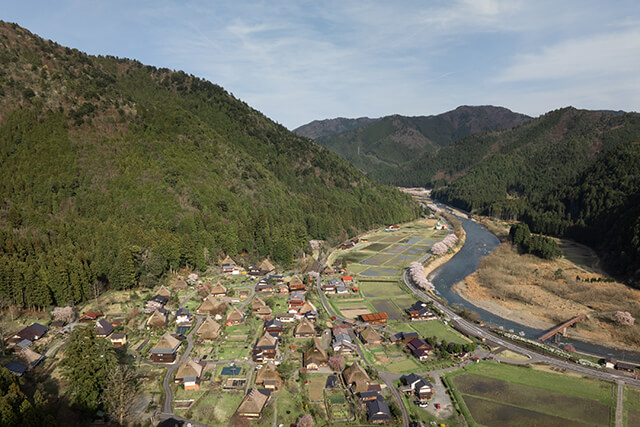
Planning your trip to Miyama, Kyoto’s picturesque thatched-roof village

Kyoto | Traditional Culture
Discover Traditional Indigo Dyeing in Miyama

Kyoto | Traveling
Visiting Kayabuki-no-Sato, Kyoto’s picturesque thatched-roof village
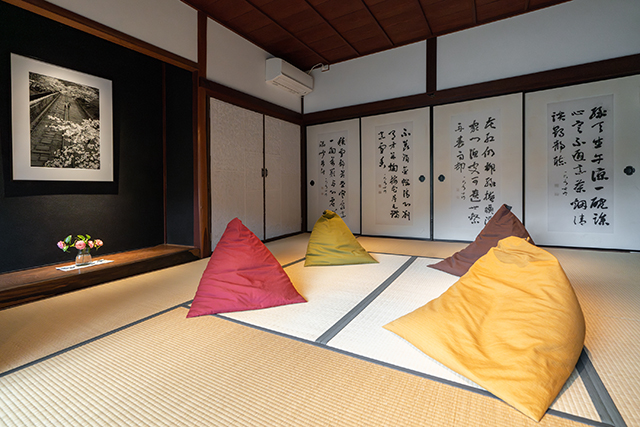
Casa Miyama: Get a Taste of Spain in an Old Kyoto Thatched-roof House
FOOD & DRINK
ART & CULTURE

Go temple hopping through Kyoto’s world heritage sites
A walking plan—the culture and cuisine from Marunouchi to Ginza
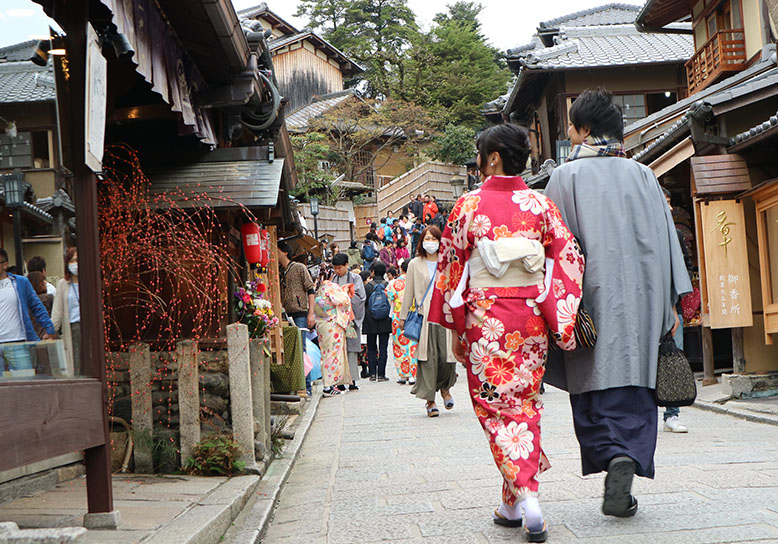
Kyoto walk—Climb “the hill” to Kiyomizu-dera Temple

Taste and see the tourist hotspots of Osaka
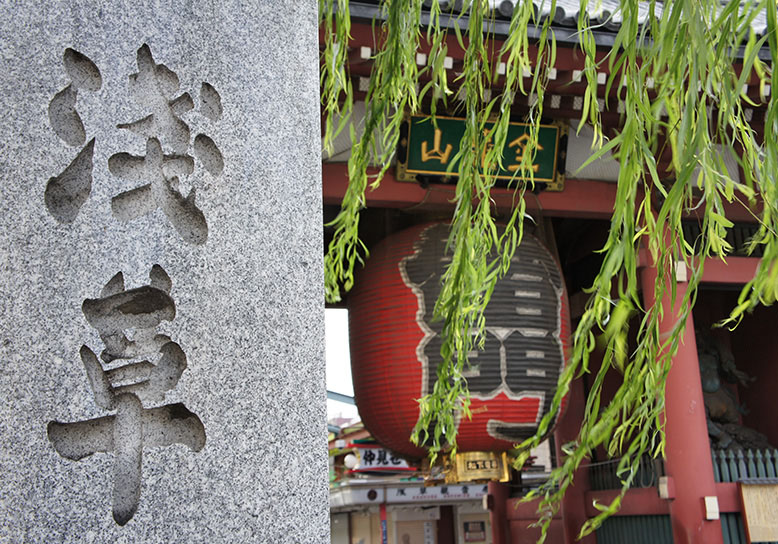
A day plan—Tokyo’s downtown culture in Asakusa, Ueno and Jimbocho
- Airline Ticket
- Tourist Pass
- International
- [Tokyo] Haneda / Narita
- Tokyo Haneda International Airport
- Tokyo Narita International Airport
- [Osaka] Itami / Kansai
- Osaka Airport
- Osaka Kansai International Airport
- Sapporo New Chitose Airport
- [Nagoya] Central / Komaki
- Nagoya Chubu Centrair International Airport
- Fukuoka / Kitakyushu
- Fukuoka Airport
- Okinawa Naha Airport
- -------- Hokkaido --------
- Okadama Airport
- Rishiri Airport
- Wakkanai / Rishiri
- Wakkanai Airport
- Ohotsukumonbetsu Airport
- Memanbetsu / Nakashibetsu / Kushiro
- Memanbetsu Airport
- Asahikawa Airport
- Nemuronakashibetsu Airport
- Kushiro Airport
- Kushiro / Obihiro
- Obihiro Airport
- Hakodate Airport
- Okushiri Airport
- --------- Tohoku ---------
- Aomori / Misawa
- Aomori Airport
- Misawa Airport
- Odatenoshiro Airport
- Akita / Odate-Noshiro
- Akita Airport
- Hanamaki Airport
- Syonai / Yamagata
- Shonai Airport
- Yamagata Airport
- Sendai / Fukushima
- Sendai Airport
- Fukushima Airport
- -- Kanto / Koshinetsu / Hokuriku --
- Narita / Ibaraki
- Ibaraki Airport
- Oshima Airport
- Miyakejima Airport
- Hachijojima Airport
- Niigata Airport
- Matsumoto Airport
- Toyama Airport
- [Hokuriku] Komatsu / Toyama / Noto
- Komatsu Airport
- Noto Airport
- ---- Chubu / Kinki ----
- Nagoya Airport
- Shizuoka Airport
- [Osaka] Itami / Kobe
- Kobe Airport
- Nankishirahama Airport
- Tajima Airport
- ---- Chugoku / Shikoku ----
- Okayama Airport
- Hiroshima / Iwakuni
- Hiroshima Airport
- Iwakuni Airport
- Yamaguchi-Ube / Kitakyushu
- YanaguchiUbe Airport
- Tottori Airport
- [Tottori] Yonago / [Shimane] Izumo
- Yonago Airport
- Iwami Airport
- Izumo Airport
- Oki Airport
- Tokushima Airport
- Takamatsu / Tokushima
- Takamatsu Airport
- Matsuyama Airport
- Kochi Airport
- --------- Kyushu ---------
- Kitakyushu Airport
- Oita Airport
- Saga Airport
- Nagasaki / Saga
- Nagasaki Airport
- Iki Airport
- Tsushima Airport
- Gotofukue Airport
- Kumamoto Airport
- Amakusa Airport
- Miyazaki Airport
- Kagoshima Airport
- Tanegashima Airport
- Yakushima Airport
- Kikaijima Airport
- Amamioshima Airport
- Tokunoshima Airport
- Okinoerabu Airport
- Yoron Airport
- --------- Okinawa ---------
- Kitadaito Airport
- Minamidaito Airport
- Kumejima Airport
- Miyako / Shimojishima
- Miyako Airport
- Tarama Airport
- New Ishigaki Airport
- Yonaguni Airport
- Aguni Airport
- Shimojishima Airport
- ---- collectively check ----
- Economy class
- Premium Economy class
- Business class
- First class
- Hokkaido / Tohoku
- Koshinetsu / Hokuriku
- Kyushu / Okinawa
- All Categories
- Transportation/Travel Service
- Gourmet Restaurant
- Marine Sports/Leisure
- River/Lake Activities
- Sight Seeing Tours/Guide Tours
- Cultural Activities
- One-day Hot Spring Trip
- Mountain/Nature Activities
- Sports/Fitness
- Entertainment/Amusement
- Snow Activities
- Sky Activities
- The Latest Activities
- Professional Activities
- Vegetable/Fruit Hunting
- Online Experience
- Other Activities/Experiences

FIREWORKS FESTIVALS
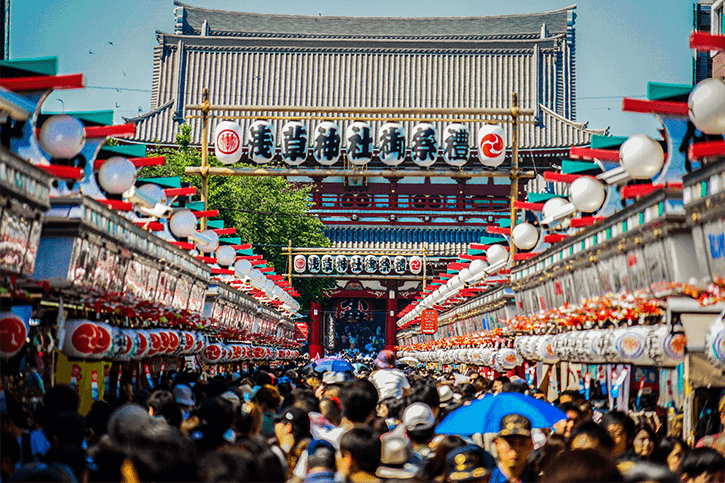
Sanja Matsuri, one of Tokyo’s top festivals, is back with a bang
Tokyo | Temples

Sawara Aquatic Flower Festivals
Japan | Guide

11 Best Places to See Hydrangeas (Ajisai) in Kanto Region
Japan | Nature

Minamisawa Hydrangea (Ajisai) Mountain
Tokyo | Nature
- OTHER SEASONS -

CHERRY BLOSSOM SEASON

AUTUMN FOLIAGE FORECAST

SKIING AND SNOWBOARDING
ABOUT JAPAN
TRANSPORTATION

The 12 Must-Visit Restaurants in Shibuya That Won’t Break the Bank
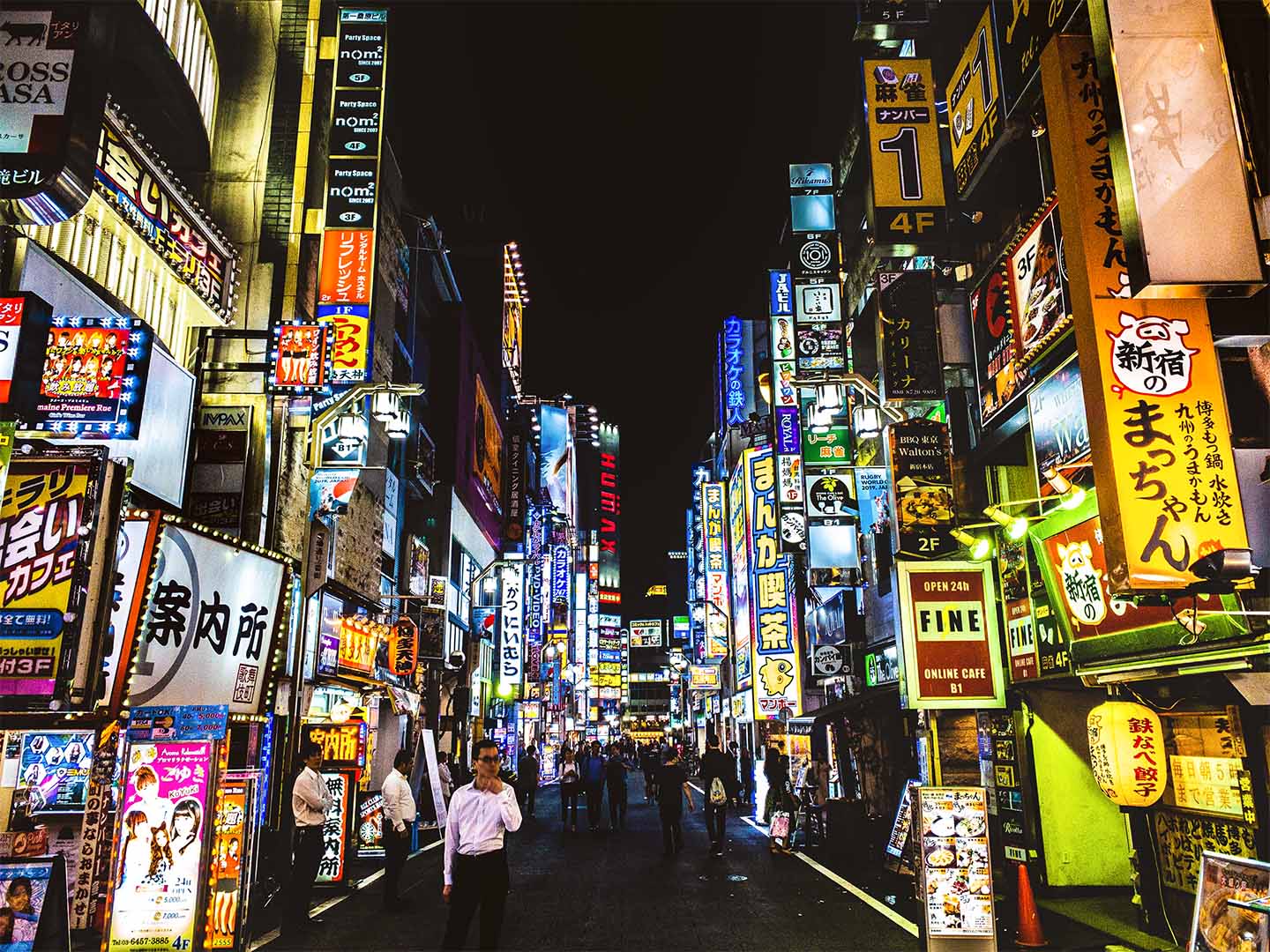
Tokyo | Need to Know
Public Safety in Japan: Tokyo Red-light Districts
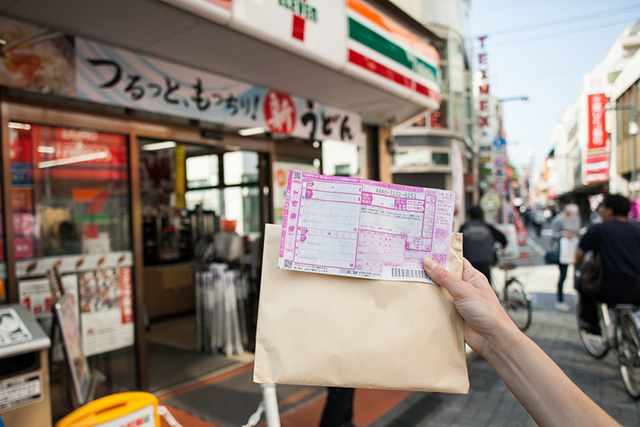
Tokyo | Travel Tips
How to Send Packages at Convenience Stores
- LATEST ARTICLES -

NIPPONIA Sawara―Merging Town and Hotel
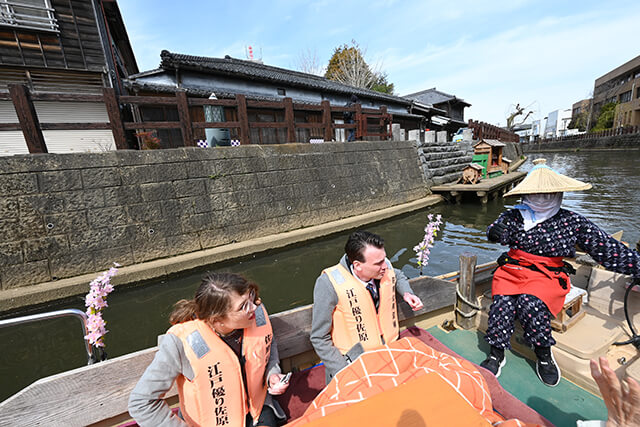
Drift Through Sawara’s Floating World
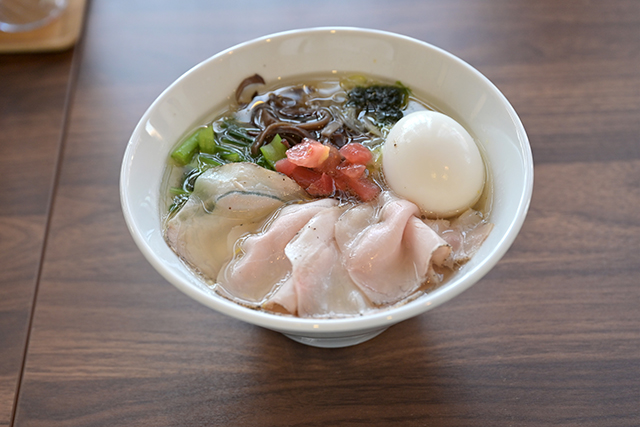
Japan | Ramen
Oodles of Noodles at Noodle Labo Kakyoan

The Hayashida’s Rice Cracker Cornucopia

Japan | Travel Tips
Airport Transfer Special Discount Coupon
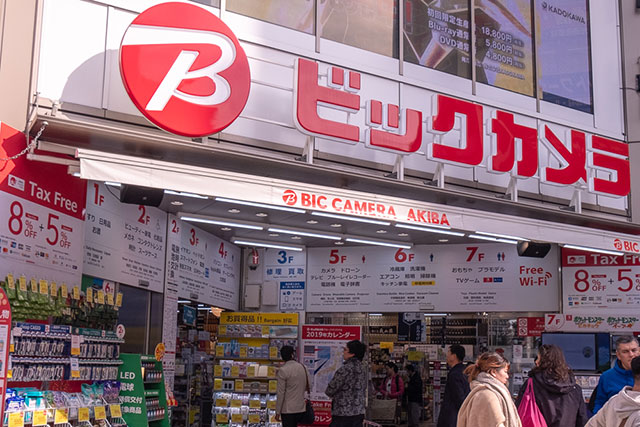
Tokyo | Coupon
BicCamera Discount Coupon

JINS Discount Coupon

Special Offer for Car Rental

You can download sightseeing magazines filled with the attractions of each of Japanese seasons - spring, summer, autumn, and winter. Browse through travel information about Tokyo, Hiroshima, Kamakura, etc., carefully selected by the editorial department of Japan Travel by NAVITIME.
View images filled with the charm of sightseeing spots throughout Japan such as Nara, Kamakura, and Morioka. Please enjoy images of Japan's unique scenery.
プライバシーポリシー ・ 利用規約 に同意の上、ボタンを押してください。
ログイン(無料)すると より便利に利用できます
Change password

Touropia Travel
Discover the World
27 Top Tourist Attractions in Japan
By Spencer Leasca · Last updated on June 21, 2024
Rich in history and culture, Japan is graced with traditional ryokans and ancient temples. But it also boasts cities like Tokyo, Kyoto, and Osaka that bustle with modern skyscrapers and high-tech gadgets.
In between, there are landscapes of breathtaking natural beauty. While the country is also a major commercial centre for fashion, cars and entertainment.
Then of course there is the food. From sushi and ramen to tempura and yakitori, Japanese food is renowned for its unique flavors and presentation. Travelers can sample traditional dishes at local eateries around the country, or indulge in Michelin-starred restaurants. Both of which will blow you away with their taste and presentation.
For the tourist, it really is a journey of Far Eastern discovery. However, the sheer diversity and wealth of tourist attractions in Japan can make it very difficult to plan a trip. This is why we’ve put together this list of things to do that will hopefully, provide you with some inspiration for where you will go in the ‘land of the rising sun’.
27. Kenrokuen Garden, Kanazawa
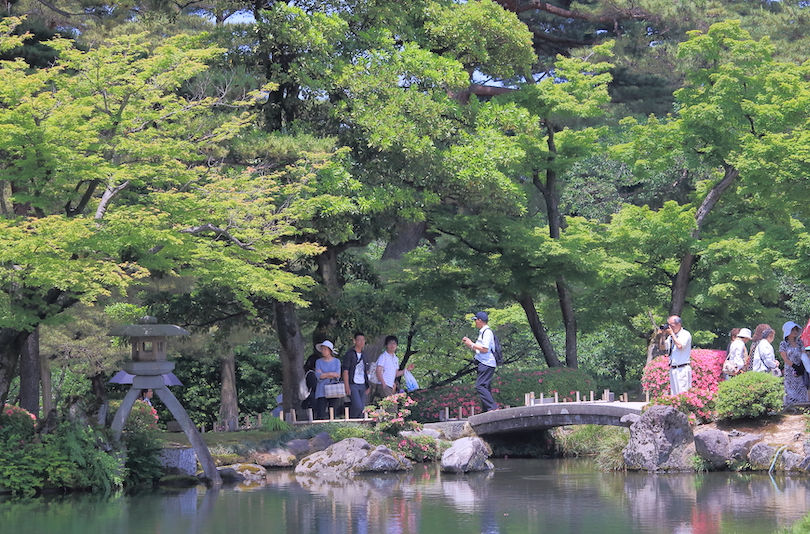
We love looking at beautiful gardens so we were very excited to see the famous Kenrokuen Garden in Kanazawa.
Established back in the 17th century its name means ‘Garden of the Six Sublimities’. This references the six qualities that the Japanese believe make up a perfect garden. Namely abundant water, antiquity, artificiality, broad views, seclusion and spaciousness.
Changing throughout the year with the season, Kenrokuen certainly encapsulates all these elements. In spring, the cherry blossoms are out in force, while in summer, the garden is very lush and green. In autumn, the leaves turn brilliant red and orange. While in winter, the garden is covered in snow, creating a majestic winter wonderland.
Whichever time of year you choose to visit, you’ll be blown away by its beauty.
26. Senso-ji Temple, Tokyo
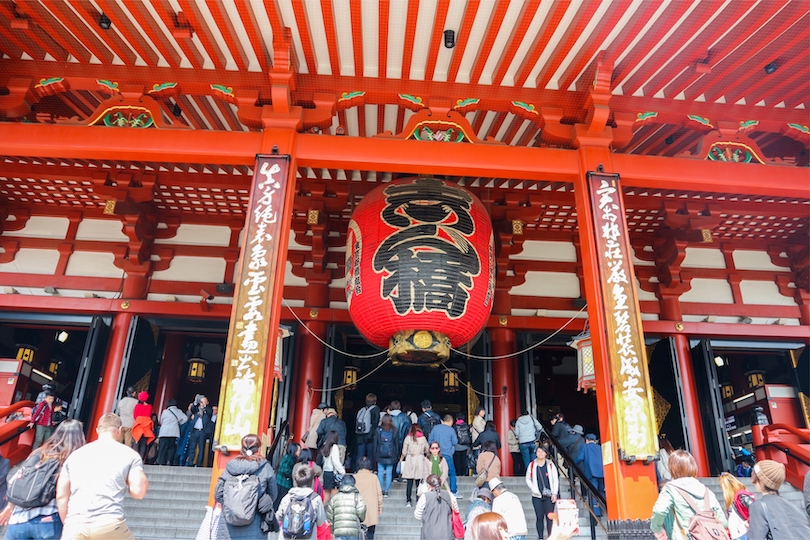
In Japan there are lots of temples. You won’t be able to see them all of course, but one you should put on your schedule is a trip to the Senso-ji Temple.
This Buddhist temple is in the Asakusa neighborhood of Tokyo . It dates back over 1300 years and is one of the city’s oldest and most famous temples.
An impressive structure, it is dedicated to Kannon, the Buddhist goddess of mercy. It is fronted by a main entrance known as the ‘Thunder Gate’. This features a large red lantern and two statues of gods.
Beyond the gate is a long shopping street called Nakamise-dori, where you can buy plenty of traditional Japanese souvenirs and snacks. You’ll also find the temple’s main hall, ‘the Hondo’, as well as a five-story pagoda, and a beautiful garden.
See also: Where to Stay in Tokyo
25. Matsumoto Castle
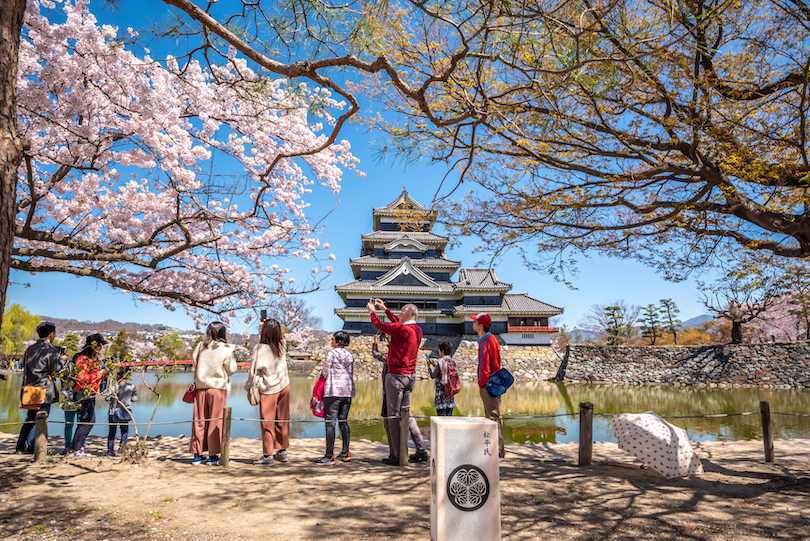
If you plan to head into the central Chūbu region we recommend you venture into the Nagano Basin. For a start, the food is fantastic there. But also, if you love snow sports, you will love the powder-covered peaks that dominate the area.
Should you go there, you’ll be able to see the magnificent Matsumoto Castle. Also called ‘Crow Castle’ because of its stunning black exterior. It is one of Japan’s most photographed structures.
Dating back to the 16th century, the castle’s design is very unique, comprising a three-layered, six-story donjon. It also has a remarkable series of walls and gates that create a maze-like layout.
You’ll be able to tour the castle’s interior. It has several exhibits and displays that relate to its history and construction. Whilst there, be sure to go to the castle’s top floor too. The panoramic views of the surrounding mountains and city are just incredible!
24. Art Island of Naoshima
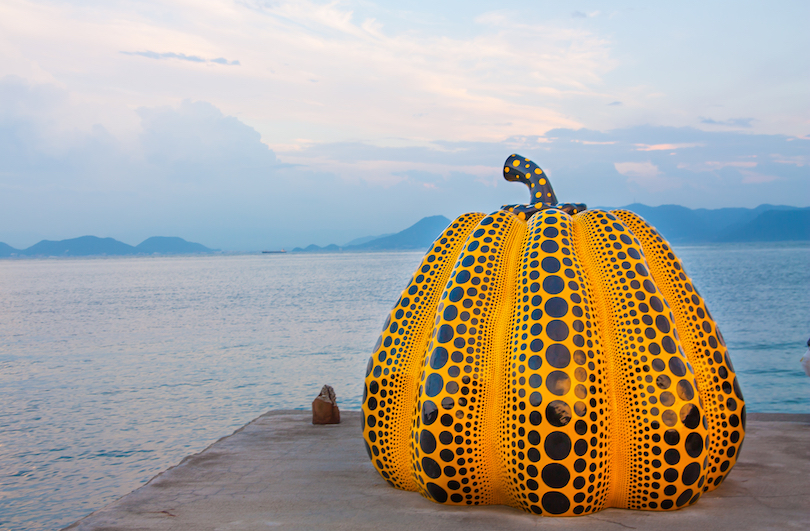
In our opinion, one of the coolest tourist attractions in Japan is The Art Island of Naoshima. Firstly, it has a dramatic location on a small island in the Seto Inland Sea that will captivate you.
But it also houses very impressive contemporary art installations, galleries and museums, you could ever wish to see.
These include the Chichu Art Museum, the Lee Ufan Museum, and the Art House Project. All of which are really pushing the envelope with their displays. If you love art, you’ll love what’s on show here.
As well as these cultural attractions, you can also visit beautiful beaches. Alternatively, you can tackle some of the hiking trails that snake around the island.
Should you want to, you can even stay overnight in one of the island’s art-themed accommodations. This is a very cool thing to do!
23. Tateyama Kurobe Alpine Route
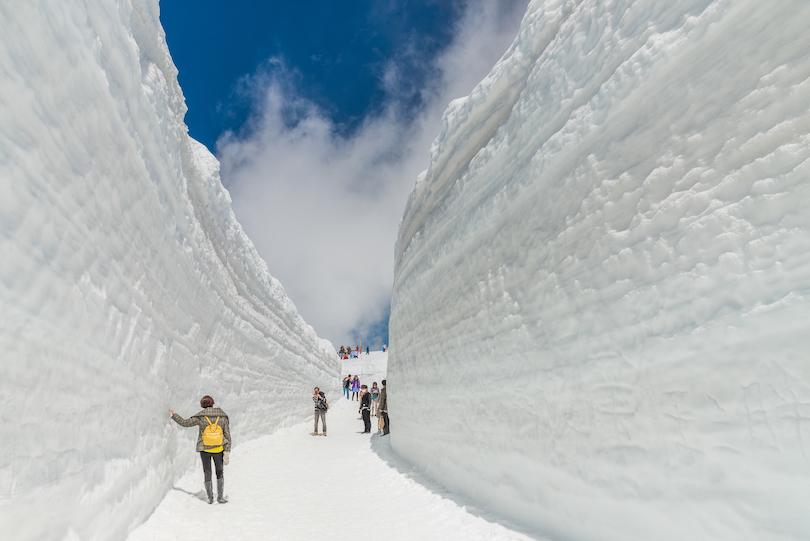
Want to do something with a bit of a wow factor? Then make sure you traverse the Tateyama Kurobe Alpine Route.
Located over in the Northern Japan Alps, this scenic mountain route spans the Toyama and Nagano Prefectures. It is known for its spectacular views of the surrounding mountains, including Japan’s highest peak, Mount Fuji.
It is also home to the Kurobe Dam, one of the world’s largest arch dams. It also accommodates the Mikurigaike Pond, which is known for its beautiful blue-green water. So there is plenty to see along the way.
The route is open from mid-April to mid-November and is a marvel of Japanese engineering. You can choose to traverse this route via bus, tunnel trolley bus, cable car or even on foot.
If you go in the spring, be sure to look out for the famous ‘Snow Wall’. This is a formidable 20-meter-high wall of snow that forms along it.
22. Osaka Dotonbori
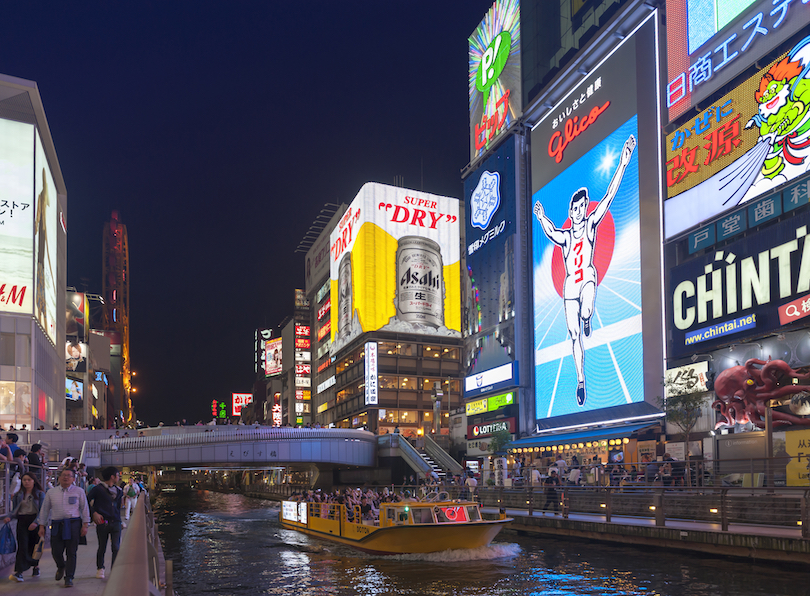
For its sheer spectacle, one of our favorite things to do in Japan at night is wandering around the Osaka Dotonbori . Not only is it a great place to people watch, but it also has a real ‘wow’ factor.
Centered around the Dotonbori Canal, you’ll instantly recognize this popular shopping and entertainment district. It has all those colorful giant neon signs and billboards, which you’ve no doubt seen on TV.
These include the iconic Glico Running Man and the Kani Doraku crab. If you are anything like me, you’ll be transfixed by both!
As well as the lights, the area is lined with shops, restaurants and bars. It also accommodates an awesome collection of street food vendors. So be sure to try the takoyaki (octopus balls) and okonomiyaki (savory pancakes) whilst you are there.
The kushikatsu (deep-fried skewers), are delicious too. Your taste buds will thank you for it!
21. Okinawa Churaumi Aquarium
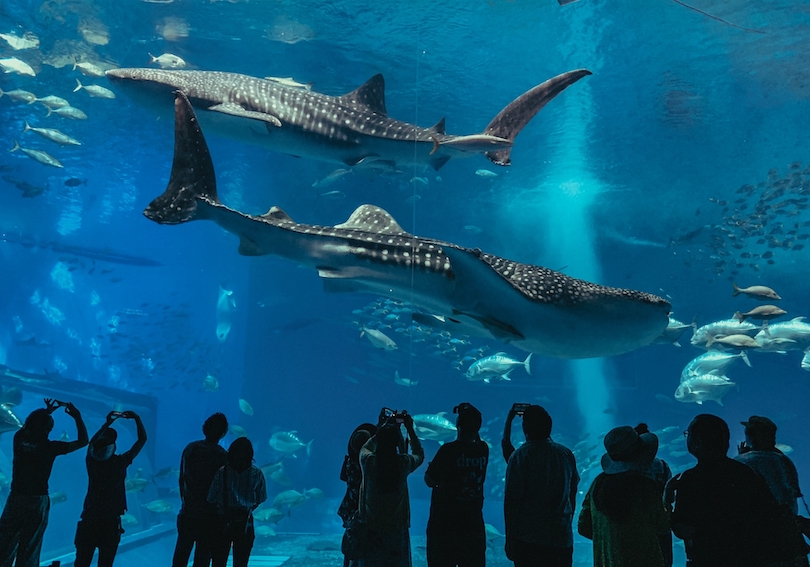
Okinawa is a lovely part of Japan to visit.
If you find yourself there with some time on your hands, make your way to the Motobu area. There you can visit the Okinawa Churaumi Aquarium. It is a terrific base to visit some of the surrounding islands.
It is one of the largest aquariums in the world. If you love looking at marine life, you’ll love what is on display here. Its main tank, the Kuroshio Sea, is one of the largest in the world. It houses whale sharks, manta rays, and giant groupers which will captivate you.
It also has a number of other cool exhibits. These include a coral reef tank, a dolphin lagoon, and an exhibit dedicated to sea turtles.
Whilst there, you can watch feeding demonstrations and attend educational programs. You can even take part in interactive experiences like touching rays and sea cucumbers too.
20. Ride A Bullet Train
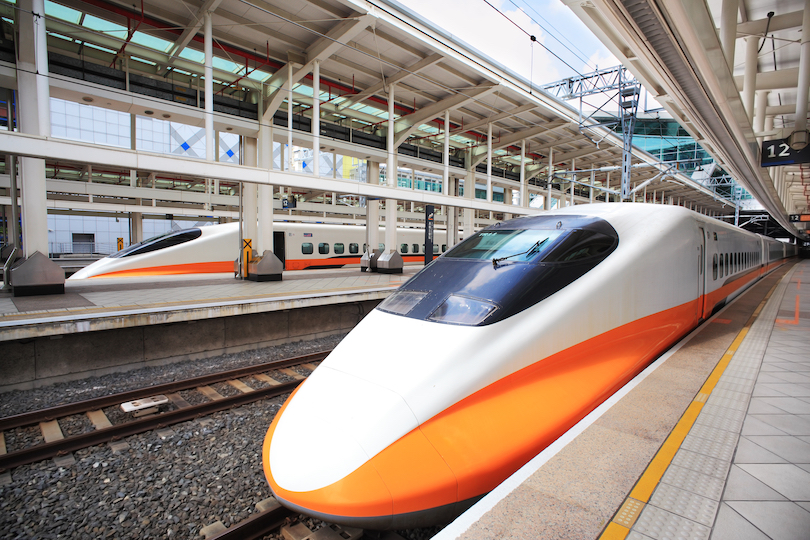
For any tourist, Japan is a big country to get around. While many people choose to fly, riding on the bullet train is an experience I can’t recommend highly enough.
Also known as a Shinkansen, these trains can reach up to 320 km per hour. They can take you from Tokyo to Osaka in just two hours!
Yet despite this, it is actually a fairly smooth and quiet ride. They are also incredibly punctual, to the point where being even a minute or two late is unheard of.
The Shinkansen network spans most of Japan’s major cities and there are regular departures and arrivals throughout the day. The trains are equipped with comfortable seats and very clean restrooms. Their food and beverage services are pretty good too.
19. Nara Park
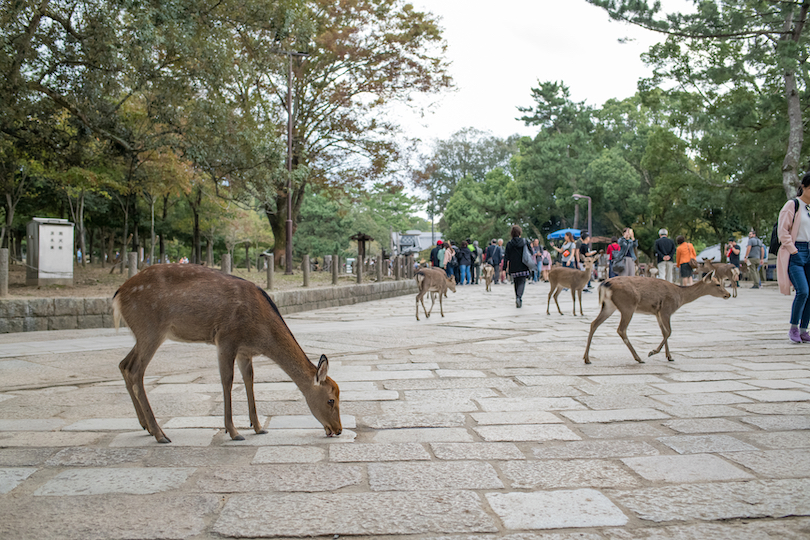
You might not have been aware of this, but deer are considered sacred in Japanese culture.
For this reason, we would suggest adding Nara Park to your itinerary of things to do if you visit Nara .
This large public park covers over 500 hectares. It is known for its population of free-roaming deer, of which there are hundreds.
If you love animals, you can buy special crackers to feed the deer, and even take photos with them.
As well as the deer, the Park also houses several famous temples and shrines, including the Todai-ji temple. This is also worth checking out because it is home to the largest bronze Buddha statue in the world.
18. Koyasan Okunoin
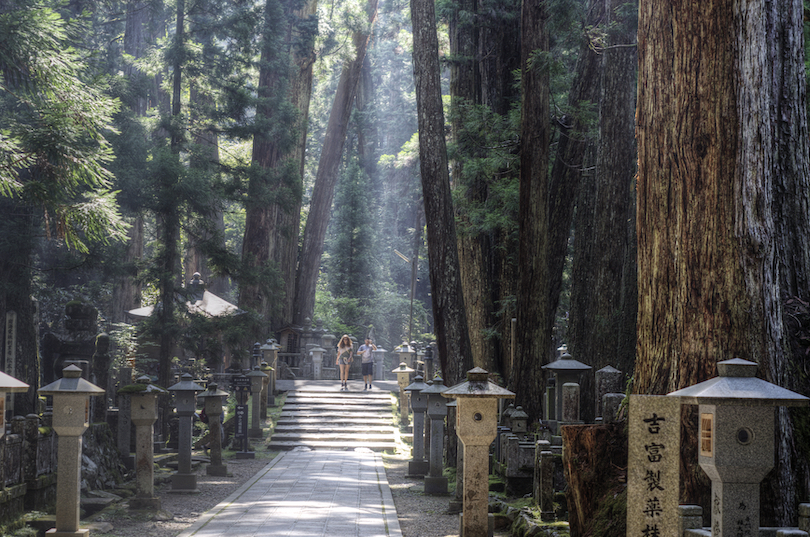
Ok, so visiting a cemetery might not be everyone’s idea of a good time when on vacation. However, the Koyasan Okunoin is a unique exception everyone should make.
Located in the Koyasan mountain range, within the Wakayama Prefecture, this sacred site is the largest cemetery in Japan. It is also the final resting place of many famous figures in Japanese history.
The impressive site is centered around the magnificent Okunoin temple. This is surrounded by a large cemetery, which contains over 200,000 tombstones and monuments.
If you want to come here, you can explore the cemetery. You can also visit some of the various temples and shrines that are dotted around the area. Additionally, the site is also famous for its lanterns. They line the paths and are lit every evening.
17. Shirakawago
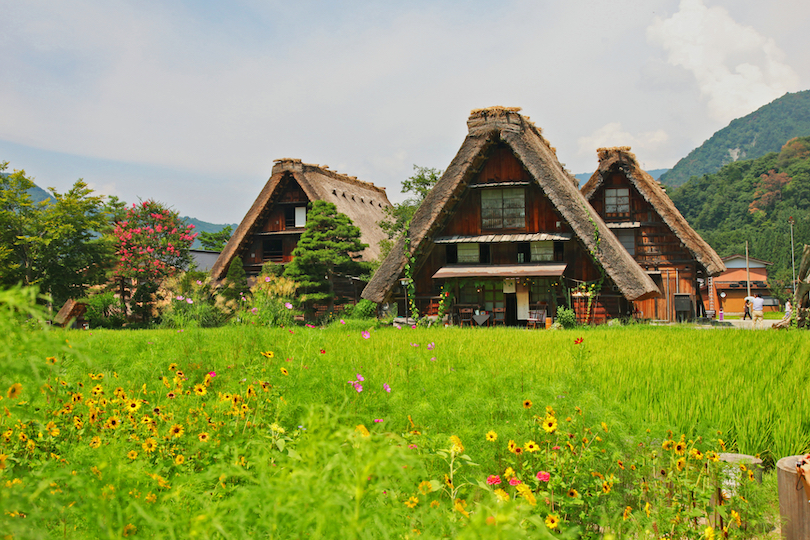
Japan is known for its cutting-edge technology. But if you want to experience life before the tech age, then it’s worth visiting Shirakawago.
Located in the mountains of Gifu Prefecture, this picturesque village is known for its authentic gassho-zukuri farmhouses. They boast inclined thatched roofs that look a lot like hands held together in prayer.
The village is actually a UNESCO World Heritage Site that showcases traditional Japanese rural life. Whilst there, you can go on a tour of the farmhouses to see its traditional architecture and lifestyle. You will also be able to learn about the history and culture of the area.
We found Shirakawago fascinating, as it provided a point of reference to what Japan used to be like. Next time we’ll time our visit with either their traditional New Year’s celebration or summer dance festival. Both of which are meant to be amazing spectacles.
16. Nikko National Park
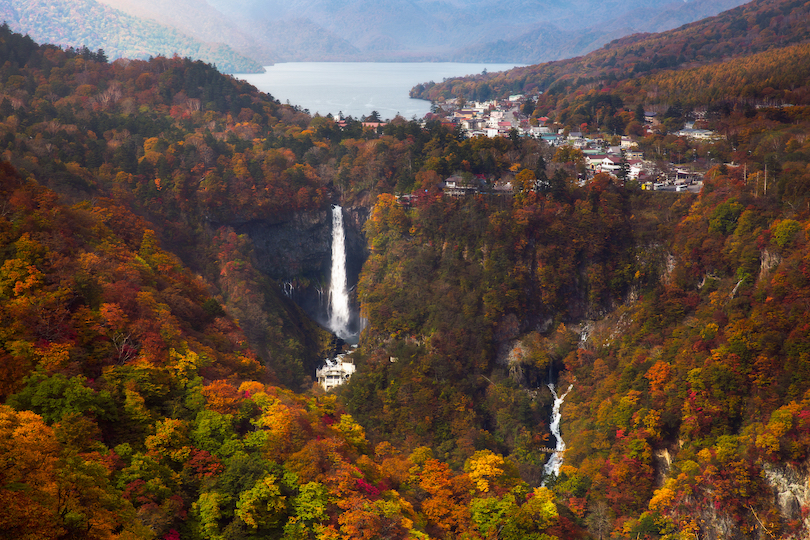
One of the most beautiful places we have ever been to in Japan is Nikkō National Park.
We visited here when we were in Tochigi Prefecture. Its stunning landscape of waterfalls, lakes, and mountain ranges blew us away.
You’ll probably need to spend a couple of days in Nikko as the park is home to several famous landmarks. Namely, the Toshogu Shrine, which is a UNESCO World Heritage Site. The Kegon Falls, is also a beautiful cascade worth visiting.
The park offers a variety of activities, including camping, fishing, and hot springs. It also hosts several traditional festivals and celebrations throughout the year.
15. Sapporo Snow Festival
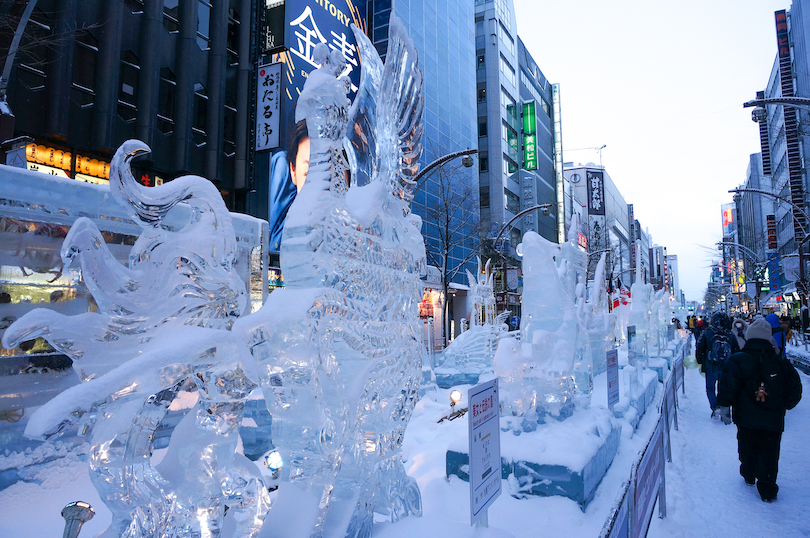
If you happen to be in Japan in January and February, then visiting the Sapporo Snow Festival is one of the smartest things to do. It is a fantastic celebration of winter sport, art and gastronomy that provides a great insight into Japan’s culture.
This popular festival is held every year in the capital city of Hokkaido. As it attracts millions of visitors, we would suggest planning ahead.
The festival is famous for its impressive snow and ice sculptures which range in size. Some are small ornate figurines. While others are massive two or three-story high structures that tower over the crowds.
The sculptures are created by insanely talented artists who showcase their skills and creativity. We really don’t know how they do it! However, their work is mightily impressive.
Being winter and with lots of snow around it will be cold. Thankfully there are lots of places to get hot chocolate or ramen to keep you warm and fed.
14. Takachiho Gorge
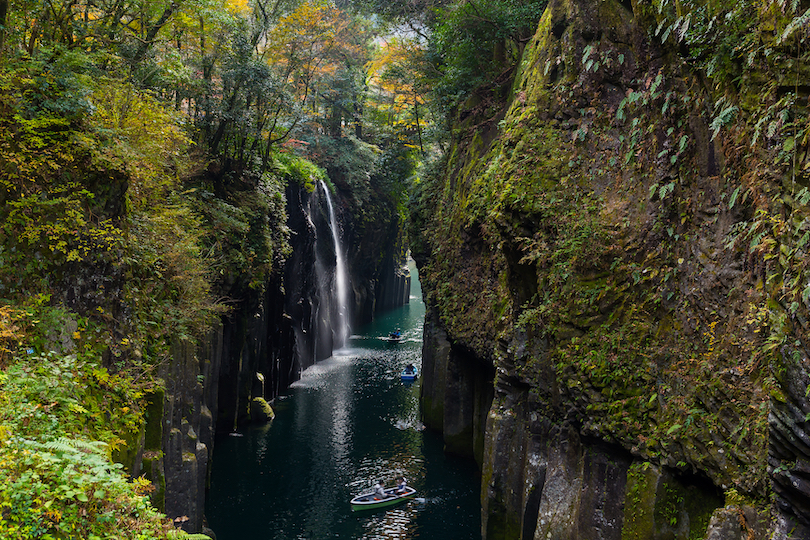
Japan is a country steeped in mythology and legend. There are lots of places you can go to experience it. For those who want to explore this folklore, one place we would suggest is the Takachiho Gorge.
According to Japanese mythology, the gorge was where the sun goddess Amaterasu hid in a cave. Thus, causing the world to fall into darkness. It is also believed to be the location where the god Susanoo slayed the eight-headed serpent Orochi.
Formed over thousands of years by the Gokase River, the gorge is a natural scenic wonder in Miyazaki Prefecture. It is known for its towering cliffs, cascading waterfalls, and emerald-green waters. These are best seen on foot via hiking trails or by traversing down the river in a rented rowboat – which, take it from us, is a lot of fun.
13. Watch Sumo Wrestling
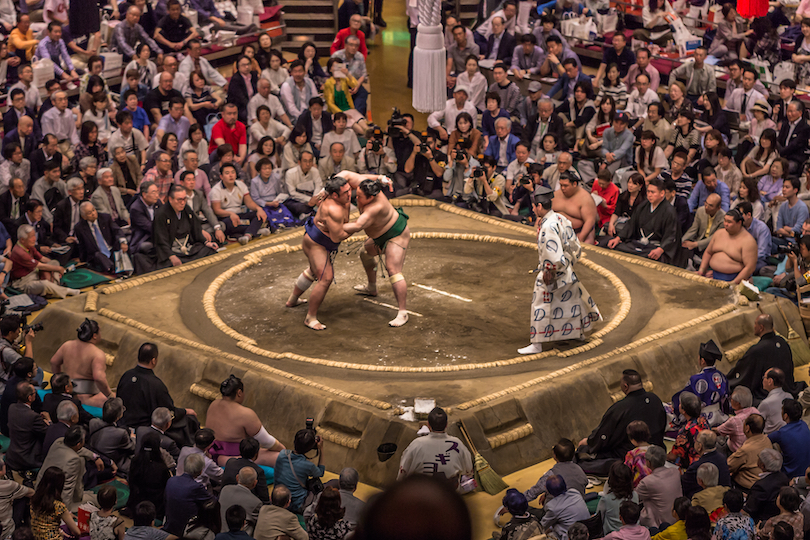
Sumo Wrestling captivated us from the first time we saw it at the Ryogoku Kokugikan in Tokyo. Located in eastern Tokyo, we went because the stadium was a short walk from Ryogoku Station. Although it cost about 10,000 yen per person to watch, it was an amazing spectacle.
Sumo is a traditional Japanese sport that dates back over a thousand years. It is not just two large men wrestling each other dressed in little more than a loin cloth. But rather a combat sport steeped in history and ritual.
If you can get to a professional sumo match it is something we would urge you to do. The matches are fast-paced and intense, and the wrestlers are incredibly skilled and agile. The atmosphere is really good too and you’ll soon find yourself cheering for your favored competitor!
Six tournaments are held in Japan each year. Three of which take part in Tokyo – which is considered to be the Sumo capital of the world.
12. Itsukushima Shrine, Miyajima
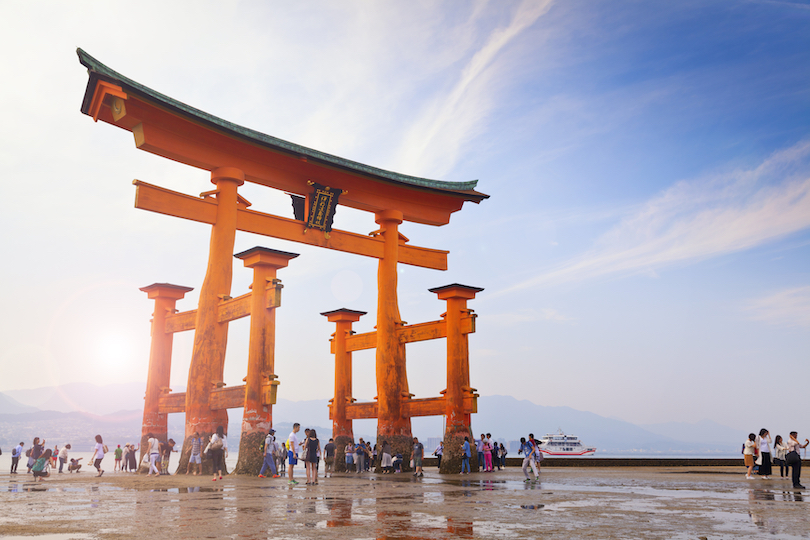
The Itsukushima Shrine is just one reason to head to the Hiroshima Prefecture . But it is a very compelling one.
One of Japan’s most iconic landmarks, it is known for its captivating torii gate. This has the incredible illusion of floating on the water. Dating back to the 6th century, the shrine is a UNESCO World Heritage Site that has mystical properties.
We were mesmerized by its magical appearance and ornate detail as we explored its various buildings and courtyards.
The shrine is easy to get to by ferry from the mainland at Miyajimaguchi Station. While you are there you can also relax in the surrounding park or hike some of its scenic trails.
11. Shibuya Crossing, Tokyo
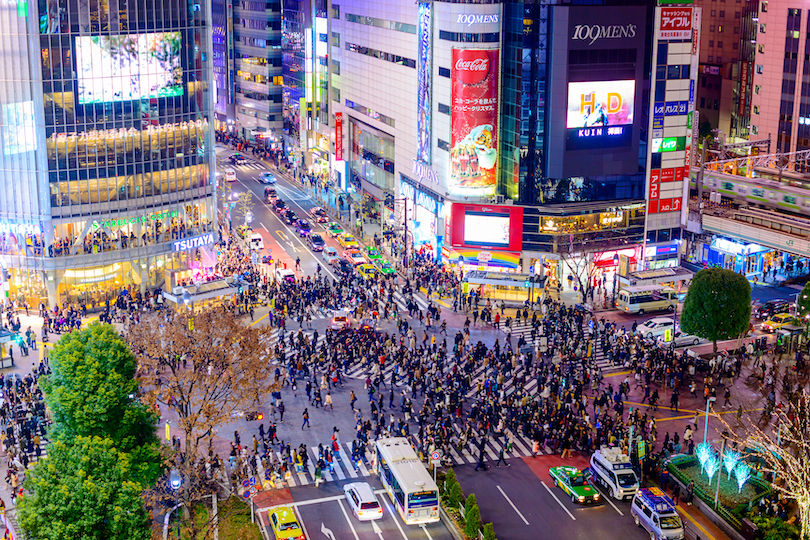
Shibuya Crossing is not a place you are likely to have to yourself. In fact, it is the world’s busiest pedestrian crossing. So, you’ll have on average about 3,000 people around you whenever you cross it.
However, it is a captivating and enchanting place to go to. Not least because of the unique atmosphere created by the sea of people that traverse it.
One of Japan’s most iconic sites, Shibuya Crossing is characterized by its large neon billboards, flashy signs and noise. It is a symbol of Tokyo and modern Japan and has appeared in countless films and television shows.
We crossed it a few times when we visited Tokyo and also spent a bit of time looking down at the pedestrians from one of the cafes perched above it.
10. Fushimi Inari Shrine, Kyoto
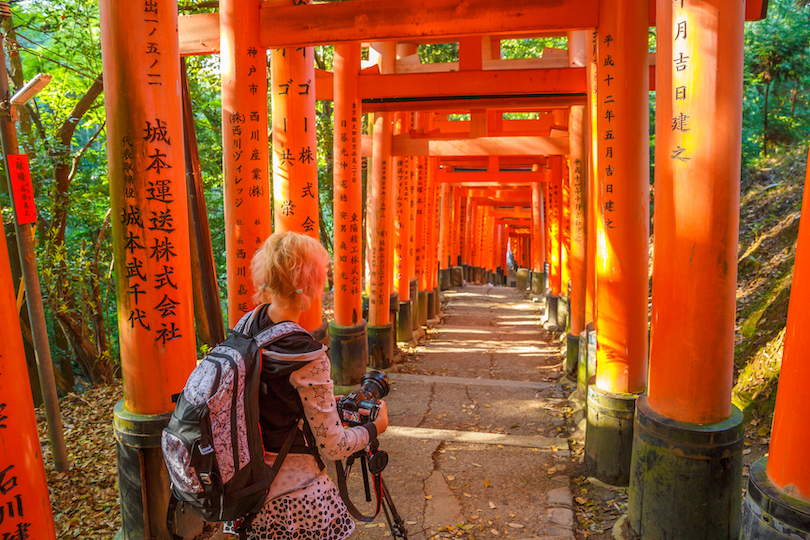
The Fushimi Inari Shrine is a remarkable site. We would strongly advise you to check out if you are in Kyoto .
Dedicated to Inari, the god of agriculture, it was founded in 711. It is famous for its over ten thousand vermillion-colored torii gates. They create a stunning site as they form a tunnel-like path up the mountain.
Many people, myself included, have walked the torii gate path, taking in wonderful views of Kyoto from the mountain. On a clear day you can see for miles, so be sure to have your Smartphone with you.
This path takes visitors through a dense forest of cedar trees. It also showcases smaller shrines and other offerings like statues of foxes. They are thought to be messengers of the god Inari.
9. Hiroshima Peace Memorial
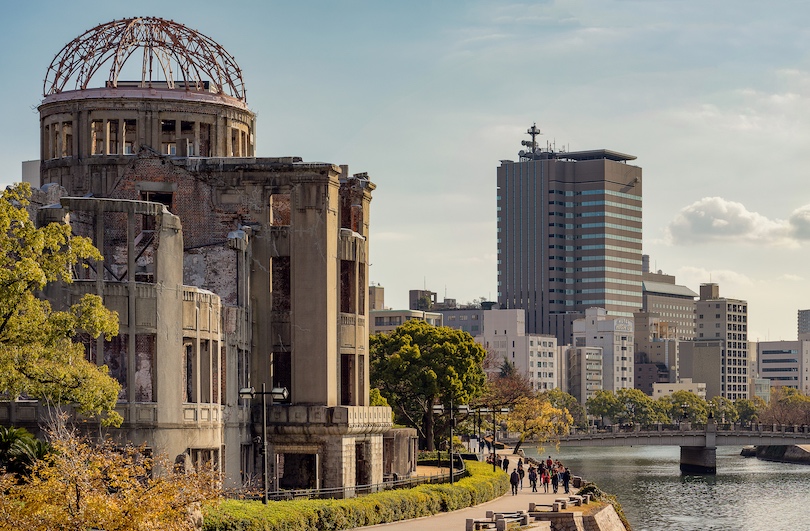
The Hiroshima Peace Memorial is one of the world’s most thought-provoking places to visit. It certainly made us think about the tragic waste of human life. As well as how the incident changed the world.
A powerful symbol of peace, it is a sombre reminder of the devastation caused by the bombing of Hiroshima.
The memorial is made up of the remains of the Genbaku Dome. This is one of the few buildings in the city to survive the bombing. It also features the surrounding Peace Park.
The surrounding park is a pleasant space to wander and features various monuments and sculptures dedicated to peace. One of which is the Children’s Peace Monument, which was inspired by a young girl called Sadako Sasaki, who died of leukaemia caused by radiation from the bomb.
8. Jigokudani Monkey Park
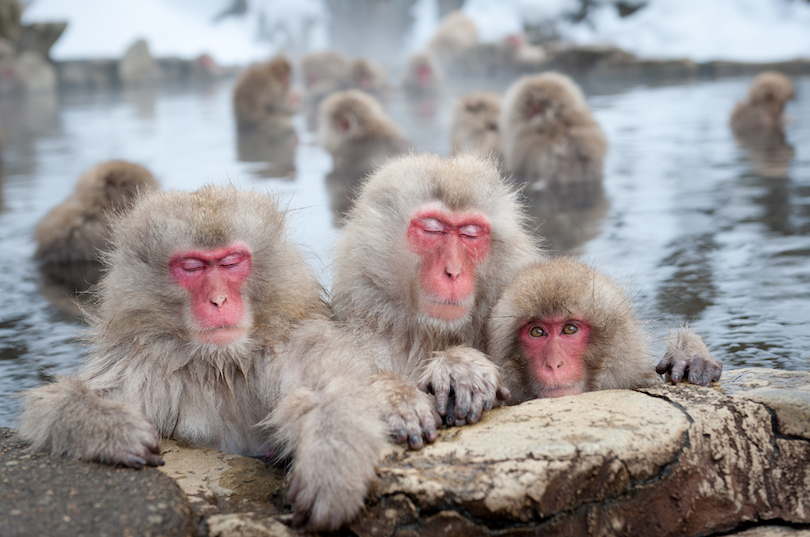
If you are not a big fan of monkeys you might want to skip to the next attraction. But if you are then you should pay a visit to the Jigokudani Monkey Park.
This popular wildlife attraction can be found in the Yamanouchi region of Nagano Prefecture. It is home to a large population of wild Japanese macaques, who are better known as snow monkeys.
What makes these creatures unique is that they are known for their unique behavior. This involves them taking hot spring baths during the winter months.
Getting to the park involves a short hike through a scenic forest trail in a mountainous region. However, the sight of the monkeys in the hot springs is worth it.
7. Kiyomizu-dera, Kyoto
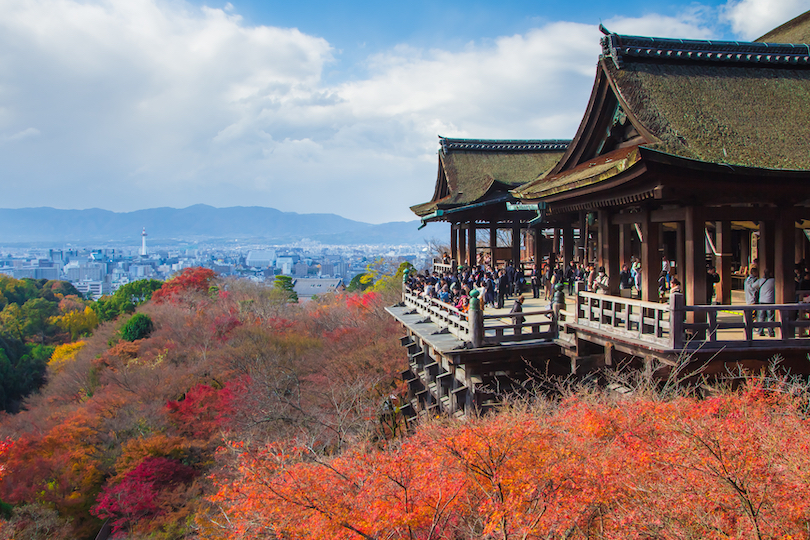
Japan has its fair share of UNESCO World Heritage sites and another one worth visiting is the Kiyomizu-dera.
This historic Buddhist temple is found in eastern Kyoto. Impressively, its main hall is built on a steep slope and is supported by wooden pillars.
The temple has the nickname ‘Pure Water Temple’ on account of its Otowa Waterfall. Here visitors can drink from one of three streams of water. Each of them is believed to have different healing properties.
If you can get there in spring, Kiyomizu-dera is particularly beautiful as cherry blossoms are in bloom. During fall, it is also spectacular when the leaves change color.
Whatever time of year you visit, as well as drinking the water, you can also enjoy panoramic views of the city from the temple’s large veranda.
6. Mount Fuji
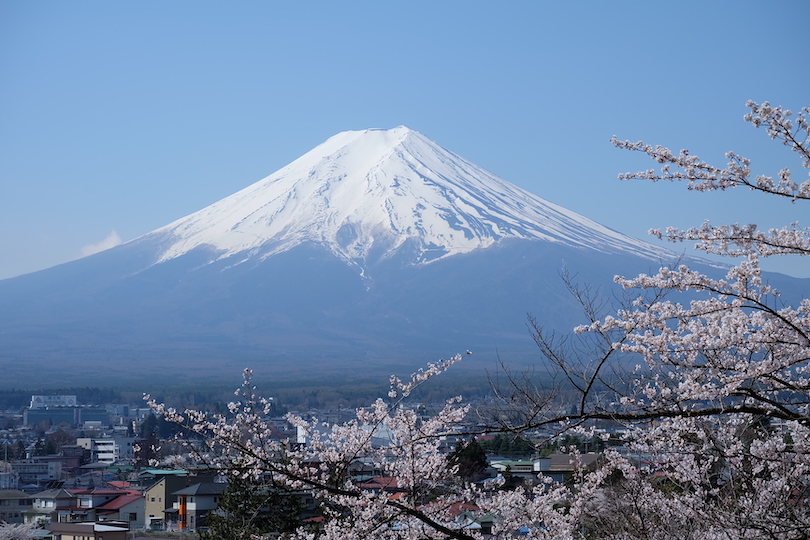
Mount Fuji is one of Japan’s most active sites, but if you intend to visit it, just be aware it is an active stratovolcano.
Situated on Honshu Island, it is the highest peak in Japan, soaring to a height of 3,776 meters. Mount Fuji is also considered a sacred site in Japanese culture, although it is a popular destination for hikers and tourists to climb.
The best time to do this is between early July to mid-September. Overall there are several trails that will lead you to the summit. Just make sure you are wearing proper shoes when you do it.
Surrounding the mountain is a beautiful national park. The landscape of which you will be able to best see on the way up.
5. Himeji Castle
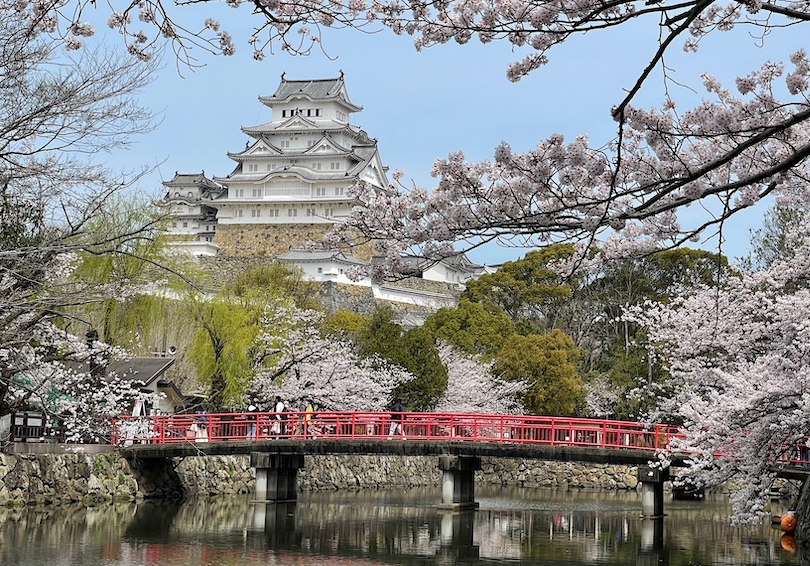
Himeji Castle is yet another UNESCO World Heritage site, but with good reason.
Known as the ‘White Heron Castle’ because of its white exterior and the way it resembles a bird taking flight, it is one of the most impressive castles we’ve ever seen.
It is also one of the few surviving original castles in Japan, as most were destroyed during wars, or by earthquakes.
The castle is surrounded by a beautiful park with cherry blossom trees and a moat. It also has numerous defensive features, including walls, gates, and towers that can be explored on a guided tour.
Inside, its ornate decor features beautifully painted screens, intricate wood carvings, and other works of art which are really impressive.
4. Great Buddha of Kamakura
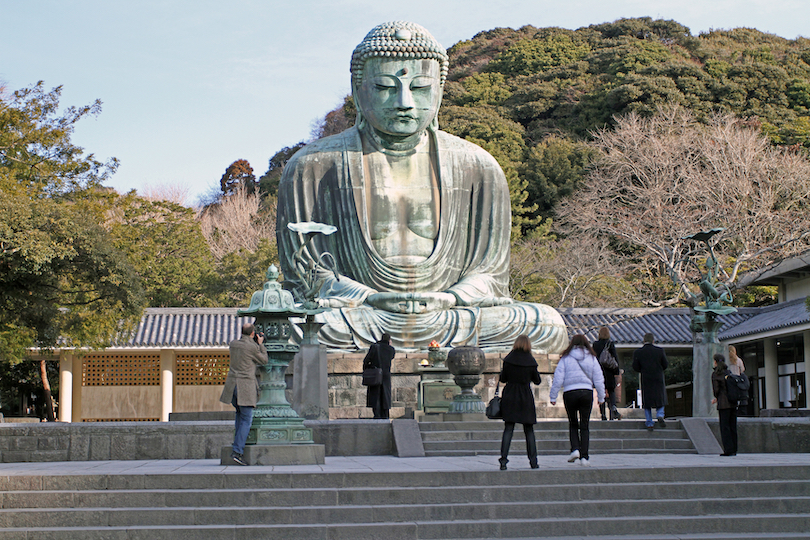
You’ll see plenty of statues of Buddha in Japan but none quite like The Great Buddha of Kamakura.
Standing approximately 44 feet tall and weighing approximately 266,000 pounds, it is considered one of Japan’s most iconic and beloved cultural treasures.
Originally cast in 1252, you will have to go to the city of Kamakura if you want to see this monumental bronze statue.
Apparently, the statue has survived numerous earthquakes and other disasters over the centuries and is considered a symbol of resilience, hope and strength.
If you go there, you will be able to explore the statue and its surroundings. There is also a small museum that presents information about the statue’s history and significance.
3. Todaiji Temple, Nara
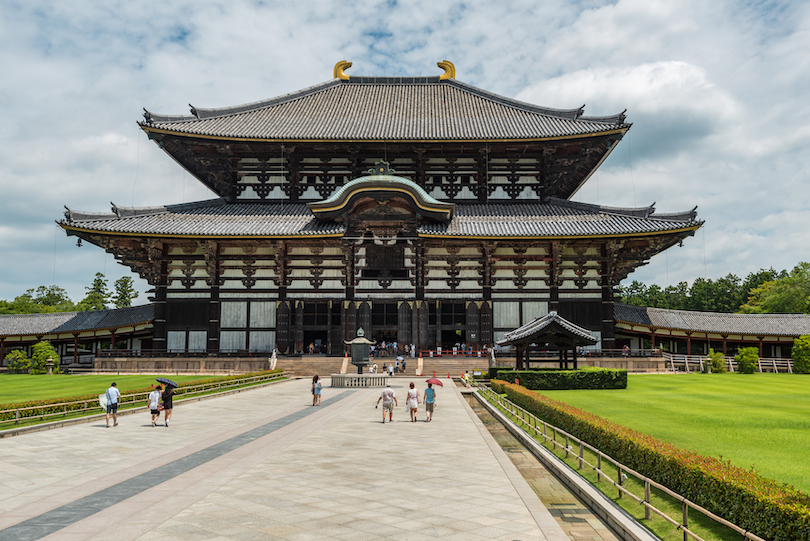
Another place where you can see a massive statue of Buddha is the Todaiji Temple.
This impressive Buddhist temple is situated in Nara and is renowned for the 52 feet high and 1.1-million-pound massive bronze statue of the extraordinary being.
The temple dates back to the 8th century and is located in Nara. Over the years it has been destroyed and rebuilt several times. However, its main hall – the Daibutsuden – remains one of the largest wooden structures in the world.
As it is a UNESCO World Heritage Site, it also contains thousands of precious art objects. While there you can also walk around its beautiful park, which features cherry blossom trees and roaming deer.
2. Tokyo Imperial Palace
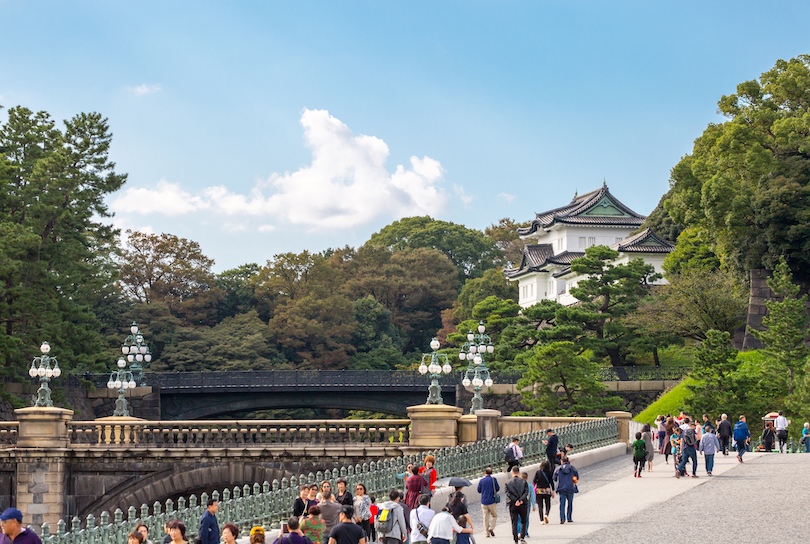
For anyone visiting Tokyo, a visit to The Tokyo Imperial Palace is a must!
Nestled in the heart of Tokyo, it is the primary residence of the Emperor of Japan. Dating back to 1457, the palace is surrounded by beautiful gardens and is a very popular tourist attraction. We would recommend you go there early to avoid the crowds.
Once there, you can take a guided tour of the palace grounds. This includes the palace gardens, as well as the outer areas of the palace complex.
The palace also houses a museum that features exhibits on the history and culture of the Japanese imperial family. This enables visitors to learn about the rituals and customs of the royal family. You can also view a collection of imperial treasures and rare artifacts.
1. Golden Pavilion, Kyoto
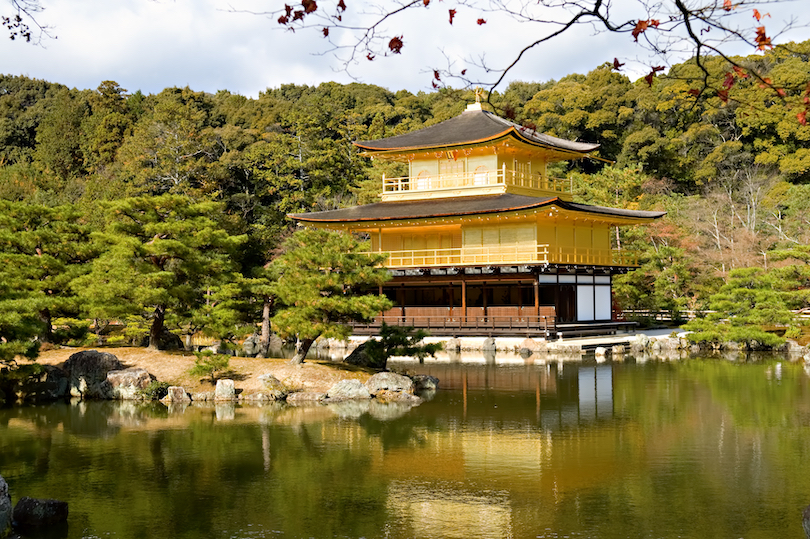
The Golden Pavilion is one of Japan’s most popular tourist attractions, and it is not difficult to see why.
Also known as Kinkaku-ji, this Zen Buddhist temple is situated in Kyoto. It is highly regarded for its stunning architecture. This notably features the top two floors of its pavilion lavishly decorated in gold leaf.
Originally it was built in the 14th century as a retirement villa for a shogun. The temple is backed by lush forest and fronted by a beautiful garden and lake.
Both of these are lovely places to stroll by – we found the lake especially enjoyable. The flora around it was beautifully arranged and reflected on the water with perfect clarity. We stopped here for a good five minutes to really appreciate the scene.
There were several other buildings, including a temple hall and a tea house that we enjoyed looking at too.
This is another place that gets very busy. So try and avoid coming in the middle of the day.
Map of Tourist Attractions in Japan
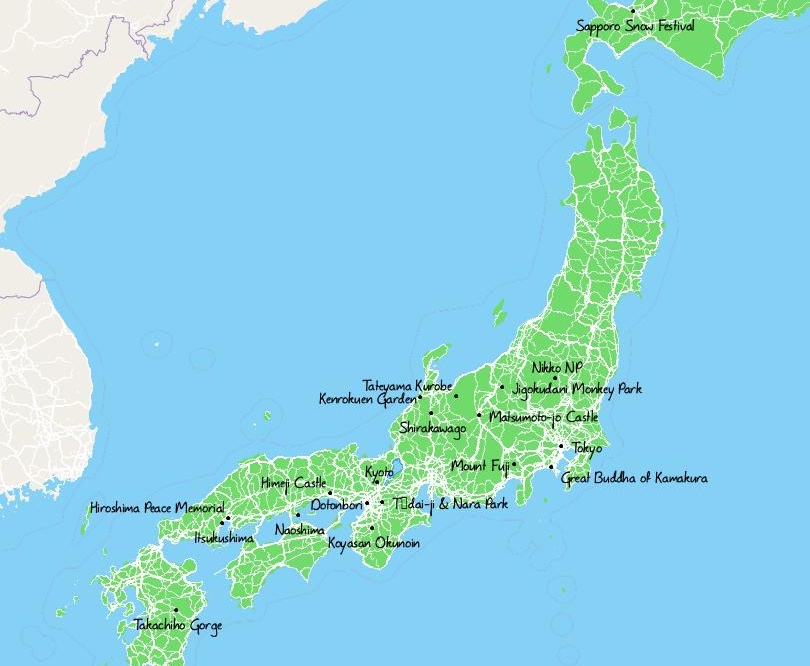
Share this post:

10 Most Beautiful National Parks in Japan

10 Largest Islands in Japan

9 Most Beautiful Regions in Japan

17 Best Places to Visit in Japan

12 Most Beautiful Castles in Japan

15 Best Cities to Visit in Japan

12 Most Beautiful Volcanoes in Japan

9 Most Amazing Hotels in Japan
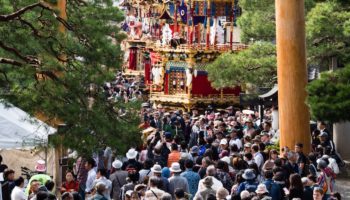
10 Best Things to do in Takayama, Japan
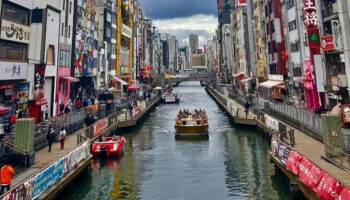
7 Fun Things to Do in Osaka
Reader interactions.
May 6, 2020 at 8:39 pm
I had been tour some famous places in Japan like Golden pavilion, Tokyo Imperial place , Tokyo tower, Todaiji Temple, and so on. I think Japan is a good place for tourism. Keep it on in the near future
September 26, 2019 at 2:45 pm
Taking the Bullet Train to Sendai and that area is nice. So many Shrines and Temples in Japan make it a very enjoyable educational experience. Love the food!
June 2, 2019 at 7:30 am
There are a ton of other great places in Japan as well, Tokyo Tower can be kinda a tourist trap, the metropatilan building gives a better view and is free.
April 24, 2019 at 9:07 am
i so want to go to japan because of reading these comments, it sounds so nice
April 2, 2019 at 1:20 am
I love Japan, especially their clean and incomparable rest rooms, their kind of discipline is so amazing!
April 21, 2017 at 3:20 pm
When I lived in Kyoto for 3 months, I fell in love with the country, Although I have to admit the Golden Pavilion I would not even put in my top 100 attractions even in the Kyoto area I hope people don’t go to it expecting much and get disappointment in Japan, my favorites were lot of the area around Uji, and Gion, or fushimi inari, or even some back allies are many times more beautiful than the Golden Pavilion in my opinion.
Rest of this list is nice tho 🙂 needs more Osaka, The Sky Garden view is breathe taking at night.
February 19, 2016 at 11:09 am
Golden Pavillion , Kyoto, is very overvallued. You can see it from long distance. Entrance fees high. My tips: 1. Tokyo; 2. Fuji-Hakone; 3. KANSAI: Kyoto; Nara; Osaka (castle-alternat. Himeji); 4. Hiroshima and Miyajima. My last trip: Tokyo – Okinawa (ANA) – Kagoshima (JRPass) – Miyazaki/Aoshima – Kyoto – Osaka – Takushima (ferry)- Osaka – Nara – Tokyo.
February 15, 2016 at 12:09 pm
So helpful and loved the monkeys
December 11, 2015 at 3:32 am
We have been to all of these during our 18 visits to Japan. We keep finding new places to go. In 2016, go to the Setouchi Triennale art festival on the islands of the inland sea. We went in 2013 and will return next year.
February 5, 2015 at 8:21 pm
i loved Japan I have been 5 times in Japan
January 30, 2015 at 1:03 am
I love Japan and want to see the Tokyo imperial Palace,mount Fuji,Tokyo Tower,Golden Pavilion.
January 12, 2015 at 6:36 pm
I love Japan it is very safe. Especially the very kind and friendly people that I met there. Experience the 100 yen stores, shinkansen, yakiniku, onsen, asakusa temple, inari temple in kyoto, himeji castle, golden pavillion was definitely amazing.
September 18, 2014 at 12:12 am
You should put skytree there
August 4, 2014 at 10:09 am
I love Japan. After around 70 countries visited it’s easily in the top 5 seen. There are many things to do there that could be in the top 10 attractions. I personally found the Golden Pavillion, although beautiful, definitely wouldn’t be number one on that list, with so many other better things to see and do.
June 11, 2014 at 4:36 pm
This website is awesome thanks for this
June 5, 2014 at 1:41 am
the himeji castle was amazing;)
May 1, 2014 at 2:52 am
Thanks for this nice sharing i also have been visited Japan about a year ago with my friend. It offers a wide range of beautiful and attractive places for the tourist. A lot of places that i like there but one place that i like the most is “Golden Pavilion”. It is a beautiful and famous temple that is located in Kyoto.
April 29, 2014 at 8:14 am
The monkeys are so cute! I was born in Japan but never knew such beautiful things were there. But, hey, where’s the SkyTree?
February 23, 2014 at 5:35 pm
I have been to a few places in your list and they are remarkable. My favourite is still Kiyomizudera in Kyoto.
August 28, 2013 at 1:35 am
so nice places i just love them.
July 26, 2013 at 4:46 am
I love Japan and specially want to see Fuji Mount.
July 17, 2013 at 2:28 am
the japan is a very nice place i love it
June 16, 2013 at 12:53 pm
The monkeys were SO CUTE!!!!!
March 20, 2013 at 12:35 am
Thankyou i found this page very interesting and helpful please produce more :):):):):) (the monkeys are very cute)
June 20, 2012 at 12:44 am
Hey you didn’t include anywhere in Osaka, there’s some great places to explore there, the arcades alone are enough of a reason to go to Osaka.
Leave a Reply Cancel reply
Your email address will not be published. Required fields are marked *
This site uses Akismet to reduce spam. Learn how your comment data is processed .

21 Top-Rated Tourist Attractions in Japan
Written by Meagan Drillinger Updated Mar 20, 2024
Japan is an enigma. It's the perfect juxtaposition of centuries-old traditions overlapped with lightning speed, cutting-edge technology. Many first-time visitors to Japan are often surprised to learn that, as one of the world's most advanced industrialized nations, this relatively small Asian country also boasts a rich and fascinating history that dates back thousands of years.
Indeed, long before many of Europe's most spectacular cathedrals were built, Japan's Shinto and Buddhist temples were already well-established and drawing pilgrims and patrons to their elaborate designs and décor. At the same time, the country was already perfecting the skills and trades that would set it on the path to riches, from fine porcelains and ceramics to textiles such as silk.
Much of this rich tradition has, despite wars and natural devastation, been preserved (or rebuilt), and a visit to Japan is a memorable adventure. Boasting an endless list of top attractions, fun things to do, and points of interest to explore, a vacation in Japan is certainly a great investment of time and money.
Discover the best places to visit in the country with our list of the top tourist attractions in Japan.
1. Mount Fuji
2. imperial tokyo, 3. hiroshima peace memorial park, 4. historic kyoto, 5. the island shrine of itsukushima, miyajima, 6. temple city: historic nara, 7. osaka castle, 8. chūbu-sangaku national park and the japanese alps, 9. the atsuta shrine, nagoya, 10. fukuoka castle ruins and the city's ancient festivals, 11. sapporo, hokkaido, 12. fushimi inari-taisha shrine, kyoto, 13. koyasan okunoin, 14. kiyomizu-dera, kyoto, 15. shinjuku gyoen national garden, tokyo, 16. hakone open-air museum, hakone, 17. naritasan shinsho-ji, narita, 18. okinawa churaumi aquarium, 19. matsumoto castle, nagano, 20. arashiyama monkey park, kyoto, 21. kenrokuen garden, kanazawa, tips for making the most of your visit to japan, best time to visit japan.

Without a doubt Japan's most recognizable landmark, majestic Mount Fuji (Fuji-san) is also the country's highest mountain peak. Towering 3,776 meters over an otherwise largely flat landscape to the south and east, this majestic and fabled mountain is tall enough to be seen from Tokyo, more than 100 kilometers away.
Mount Fuji has for centuries been celebrated in art and literature and is now considered so important an icon that UNESCO recognized its world cultural significance in 2013. Part of the Fuji-Hakone-Izu National Park , Mount Fuji is climbed by more than a million people each summer as an act of pilgrimage, which culminates in watching the sunrise from its summit.
While some still choose to begin their climb from the base, the majority of climbers now start from above the halfway mark, at the 5th Station, resulting in a more manageable six-or-so-hour ascent. Those who do attempt the complete climb are advised to depart in the afternoon, breaking up the climb with an overnight stop at one of the "Mountain Huts" designed for this very purpose. An early start the next day gets you to the top for the sunrise.
Of course, for many, simply viewing the mountain from the distance, or from the comfort of a speeding train, is enough to say "been there, done that."
- Read More: Exploring Mount Fuji: A Visitor's Guide

Tokyo's most famous landmark, the Imperial Palace with its beautiful 17th-century parks surrounded by walls and moats, is a must-see when visiting the nation's capital. Don't be put off by the fact that the majority of the palace is closed to the public (it's still in use by the Imperial family), as there is still enough to see simply by strolling the grounds.
In addition to the many fine views of the palace from numerous points in the surrounding parkland, visitors are permitted into the East Higashi-Gyoen Garden and other areas that are opened to the public as part of an organized tour. One of the most romantic views is of the famous Nijubashi Bridge , or "double bridge," so named for its watery reflection.
Another one of the must-sees for tourists visiting Tokyo is the famous Ginza shopping district. This always bustling area is home to the Kabuki-za Theatre with its Kabuki performances, as well as the Shimbashi Enbujo Theatre with its traditional Azuma-odori dances and Bunraku performances.

While little needs to be said here of the horrors of the atomic bombing of Hiroshima in August 1945, much can be said of the incredible efforts this vibrant city has made to commemorate the many victims of the world's first nuclear attack. Perhaps even more importantly, Hiroshima has become a symbol of lasting peace.
Visited by more than a million people each year, many from overseas, Hiroshima Peace Memorial Park (Hiroshima Heiwa Kinen Kōen) lies at the epicenter of the atomic blast in what was once a bustling part of the city. Here you'll find a number of important monuments, memorials, and museums relating to the events of that fateful day.
In addition to the grounds and gardens with their colorful cherry blossoms, the park is where you'll find the Peace Memorial Museum, with its numerous exhibits dealing with the issue of world peace. It's also where you'll find the Memorial Cenotaph and the Flame of Peace , as well as the Atom Bomb Dome , the ruins of an administrative building that lay at the center of the explosion.
- Read More: Top-Rated Tourist Attractions in Hiroshima

One of Japan's most visited cities, lovely Kyoto – one of the few cities in the country to be spared the devastation of WWII – attracts more than 10 million visitors annually. Most of them are here to explore Kyoto's fine old streets and architecture, much of it unchanged since the Imperial family took up residence here more than 1,000 years ago.
Even then, the city was Japan's most important cultural center. This legacy, in fact, continues to this day with its many museums and art galleries, each bursting with important sculptures, paintings, and other art forms.
Highlights of Kyoto's Buddhist-influenced architecture include its many well-preserved temples, 30 of which are still in use, and important structures such as the 14th-century Golden Pavilion (Kinkaku-ji), famous for its exquisite gold-leaf-clad exterior.
Be sure to also visit Nijo Castle , a 17th-century fortress that has retained its original walls, towers, and moat. Also worth seeing are the castle's beautiful gates, along with its palace with fine interior décor.
Another landmark to visit is the original Kyoto Imperial Palace (Kyoto-gosho ) . Built in AD 794, it's one of the city's most visited historic sites.
Finally, no visit to Kyoto is complete without spending time exploring the Arashiyama Bamboo Grove . This beautiful area of tall bamboo is just a few minutes' walk from the town center.
- Read More: Top-Rated Tourist Attractions in Kyoto

Just a short ferry ride from mainland Hiroshima is the island of Miyajima , famous the world over as Japan's Shrine Island. Covering an area of 30 square kilometers in Hiroshima Bay, Miyajima is best known as the home of the Itsukushima Shrine, a Shinto temple dedicated to the Princess daughters of the wind god Susanoo.
Dating from the eighth century, the majority of the shrine's buildings rise out of the waters of a small bay supported only by piles. The effect at high tide is simply stunning, making these structures - including the famous Great Floating Gate (O-Torii) - appear as if they're floating on water.
Linked together by walkways and bridges, it's a fascinating place to explore, in particular its larger halls. These include the exquisite Honden (Main Hall), the Offerings Hall (Heiden), the Prayer Hall (Haiden), and the Hall of a Thousand Mats (Senjokaku).
Another notable feature is the shrine's stage, where visitors are entertained with traditional dances and musical performances. Also worth exploring are the island's exquisite grounds and gardens, home to wild deer and numerous bird colonies.
Please note: You can expect some interruptions and inconvenience from now until 2022 due to major renovations taking place at this historic site.

For centuries the hub of Japanese culture, the lovely unspoiled city of Nara is home to a large number of historic buildings, along with important national treasures and works of art.
In addition to its many historic streets, the city boasts numerous important old temples. These includ the magnificent seventh-century Kofuku-ji Temple , perhaps the best known of the Seven Great Temples of Nara; and the splendid eighth-century Todai-ji (Great East Temple), famous for its huge bronze statue of the Great Buddha (Daibutsu), cast here in AD 749.
Also of interest in Todai-ji are its Great South Gate (Nandaimon). This spectacular two-story structure is borne on 18 columns, with two Nio statues standing eight meters tall, and it guards the temple entrance. Also of note here is the Hall of the Great Buddha, the world's largest timber building.
- Read More: Top-Rated Tourist Attractions in Nara

Built in 1586 by famous Japanese warrior and politician Toyotomi Hideyoshi , Osaka Castle (Ōsaka-jō) was at the time the largest and most important fortress in the country. Although destroyed and rebuilt a number of times since, the present structure, built in 1931, remains true to the original.
Highlights of a visit include the huge five-story, 42-meter-tall main tower. Built on an imposing 14-meter-tall stone base, the tower is home to a number of displays detailing the history of the castle and the city. Be sure to visit the top floor for its superb views over Osaka, an especially attractive sight as the sun sets.
Also of interest in Osaka Castle Park is the Hokoku Shrine , while Osaka's best-known temple, Shitennō-ji , is also worth visiting and dates back to AD 59. Notable as Japan's first Buddhist temple, this lovely shrine features a five-story pagoda along with a number of other exquisitely decorated buildings. Among them are the Golden Pavilion (Kondō), with its fine statues and paintings; the Lecture Hall (Kōdō); and a lovely covered corridor linking three of the site's gates.
- Read More: Top-Rated Tourist Attractions in Osaka

Japan boasts a number of outstanding areas of natural beauty, many of them designated as national parks or, in some cases, UNESCO World Heritage Sites. One of the country's most spectacular of these is Chūbu-Sangaku National Park in the center of Honshu. Located in the park's northern and central regions is the group of mountains collectively referred to as the Hida Mountains , or Japanese Alps.
This region contains some of the highest peaks in the country, including Hotaka at 3,190 meters, and Yari at 3,180 meters. Similar in many ways to the Alps of Central Europe - both in the character of the landscape and in its abundance of snow in winter - the Japanese Alps attract large numbers of walkers and climbers in summer and skiers in winter.
Of particular interest is the park's abundance of flora and fauna, including the rare ptarmigan and mountain antelopes found at higher altitudes. The park's many hot springs also draw visitors and led to the development of various spas and holiday resorts, the best known being Kamikōchi .

The Atsuta Shrine, in the heart of the city of Nagoya, is the most important Shinto shrine in Japan, and attracts more than five million visitors each year. Established in the first century, this religious site is famous for its preserved Imperial insignia, the "grass-mowing sword" (kusanagi-no-tsurugi), one of only three in the country.
Also of interest are its principal shrine, Hongu, surrounded by an enclosing wall, and the treasury with its numerous works of art, including old and modern paintings, ceramics, jewelry, and traditional masks. While in Nagoya, be sure to also visit Nagoya Castle . This splendid moated complex was built in 1612 and boasts a 48-meter-high main tower that is famous for its two gilded dolphins (shachi). It's also a popular place to visit for its museum, containing art treasures from the former palace, and its spectacular views over the city and the Nobi Plain.
- Read More: Top-Rated Tourist Attractions in Nagoya

The ruins of the once-grand Fukuoka Castle (Fukuoka-jō), built in the early 1600s, punctuate the middle of Maizuru Park. The castle was once a fine example of the prolific and majestic hilltop homes preferred by Shoguns and city rulers. But it was destroyed after the Meiji Restoration as a backlash against the feudal system.
Today, only the ruins of the castle remain, including the main gate and one of the turrets. Visitors mainly come here for the leafy walking trails and scenic lookouts, with beautiful views over the Naka River. If you climb to the top of the ruins, you can see views of the city beyond. The park is especially lovely in spring when the cherry blossoms are in full bloom.
Fukuoka is also well known for its many events and festivals. The best-known of these is Hakata Gion Yamakasa , a famous two-week long, 700-year-old celebration held each July that draws millions of visitors from across the country to its colorful parades, as well as its traditional races and costumes.
The city is not without its modern attractions, too. Most notable among them is Canal City Hakata , a-city-within-the-city complete with a canal running through the complex, along with great shops, hotels, restaurants, and a theater.
- Read More: Top-Rated Tourist Attractions in Fukuoka

Located on Japan's northernmost island, Hokkaido, the city of Sapporo offers many things to do for tourists . As the island's largest city, it's a hub of cultural activity, hosting many excellent events and festivals. It also has a distinctive culinary style; a rich theatrical history; and plenty of museums, galleries, and parks.
The focal point here is very much the city's attractive downtown area, the center of which is Odori Park, a large swath of green that's very pleasant to explore. From here, you can also access points of interest such as the Sapporo TV Tower , as well as the city's famous aerial tramway, an easy walk away. The Mount Moiwa Ropeway will eventually get you to the summit's Upper Station, from where you can enjoy incredible views over the city, a real treat at night.
The mountain is also the location of the Mount Moiwa Ski Resort, a popular winter destination, especially since the 1972 Winter Olympics were held in the city. And if you're arriving in winter, be sure to visit the Sapporo Snow Festival , held here each February and drawing in excess of two million revelers.

When you visit Fushimi Inari-taisha Shrine, you'll be seeing red – but in a beautiful way. One of the most important shrines in Japan, the Fushimi Inari shrine is found in southern Kyoto, made famous for the thousands (yes, thousands) of scarlet-colored gates that arch over a web of trails. These arch-covered trails command silence, so expect a very peaceful walk towards the forest around Mt. Inari.
Inari is the Shinto god of rice – one of the most important gods in Shintoism. Of the thousands of shrines dedicated to him, Fushimi Inari is decidedly the most important. Most travelers come to see the vermilion gates, but the shrine itself is also open for exploration, and the buildings are quite spectacular.
Visitors can also hike to the top of Mt. Inari, which takes roughly two to three hours round-trip. The route up the mountain is dotted with shrines and smaller gates, as well as spots to grab something to eat.

While a cemetery may not seem like an obvious top attraction, Japan's Koyasan Okunoin is a great exception. One of the most sacred places in the country, this popular pilgrimage spot holds the mausoleum of Kobo Daishi, the founder of Shingon Buddhism.
Daishi, also called Kukai, is one of the most important figures in Japan's Buddhist history. It is said that he sits in eternal meditation while waiting for the Buddha of the Future. Those who make the pilgrimage to his mausoleum do so to ask for salvation in this life.
Upon reaching the cemetery, visitors will cross the Ichinohashi Bridge, which is the first bridge into the cemetery. On the way to the mausoleum, visitors will pass more than 200,000 tombstones. The path leads to Gokusho Offering Hall, where visitors can make offerings, as well as pray for family members they have lost.
A second bridge, the Gobyobashi Bridge, is what separates the most sacred center of the site from the rest of the cemetery. Here is where you'll find the Miroku Stone, as well as Torodo Hall, which is a main worship hall just in front of the mausoleum. The hall is aglow with thousands of lanterns. Behind the hall is the mausoleum itself, and it is a most awesome experience to visit.
You'll feel the power of something – whether you believe or not – as pilgrims from all over the country have come to chant and pray in the presence of Kobo Daishi.

Kyoto is practically overflowing with gorgeous sites and landmarks. The city is a top attraction itself. But one can't come to Kyoto without visiting Kiyomizu-Dera, or the Pure Water Temple.
One of the most important temples in Japan, Kiyomizu-Dera was built in 780 CE on the grounds of the Otowa Waterfall. It was originally built to be part of the Hosso sect of Buddhism, but later formed its own sect in the mid 20th century.
Today the UNESCO World Heritage Site is known for its wooden stage, which overlooks the beautiful rooftops of Kyoto, and the marvelous trees that always put on fantastic color displays in both the fall and cherry blossom season.
On the grounds, visitors will find other important sites, like the Jishu Shrine, as well as the Otowa Waterfall itself, which still gushes at the base of the monument's main hall.

One of Tokyo's most famous districts is the Shinjuku district, known for its electric nightlife, trendy restaurants, and upscale hotels. But the heart of the district is also home to one of Tokyo's most naturally beautiful attractions – the Shinjuku Gyoen park.
Within the park are sprawling green spaces and trails of walking paths that wind around stunning floral displays, ponds, and manicured shrubbery. Come cherry blossom season, the park is one of the best spots to catch the brilliant waves of powder pink.
The park was built during Japan's Edo Period (1603-1867) as the residence of a feudal lord. After that it became a botanical garden and then was an entertaining grounds for Japan's Imperial Family in the early 20th century. It opened in 1949 as a public park.
Within the park are three different styles of garden, including a Japanese landscape, English landscape, and French landscape.

The town of Hakone, located within the Fuji-Hakone-Izu National Park to the west of Tokyo, is known for its stunning mountains and tranquil hot spring resorts. That is reason enough to visit this stunning small town. But another top draw to this peaceful bit of paradise is the impressive Open-Air Museum.
True to its name, the outdoor museum is a sculpture park that spreads over 17 acres. Opened in 1969, it is one of the first open-air museums in Japan, featuring more than 100 sculptures all over the grounds.
One of the most impressive sculptures here is the Symphonic Sculpture, which allows visitors to climb a stained-glass tower to reach a viewing platform that overlooks the surrounding mountains, as well as the other works of art on the grounds.
In addition to the outdoor exhibits, the museum has an indoor exhibit, including one of the world's most impressive collections of Picasso . You'll find more than 300 of the great Spanish painter's works here, including his oil paintings, prints, ceramics, and sculptures.

Dating back more than 1,000 years, the Naritasan Shinshoji Temple is one of the most popular Buddhist temples in Japan. The purpose for the temple was to protect and pay homage to a statue of the Buddhist god, Fudo Myoo, which is said to have been carved by Kobo Daishi. Within the temple grounds are several buildings, including several different style pagodas, a park, and the main halls.
Approaching the temple complex is like stepping back in time. The half-mile journey from the rail station to the temple complex is a road lined with restaurants and handicraft stores. The same has been true of this street for hundreds of years. While the stores themselves may have a 21st-century appeal, the arrival experience to the temple complex has remained unchanged for centuries.

Japan's Okinawa archipelago consists of more than 150 islands that speckle the area between Taiwan and Japan's mainland. This tropical environment is completely unique to other areas of Japan, home to beautiful beaches and swaying palm trees. The main island is also called Okinawa, and is home to several museums, as well as the Churaumi Aquarium.
The aquarium is widely considered to be the best in Japan, known for its Kuroshio Tank. Within this massive tank are about 60 different species of animals, but most visitors come to see the gigantic whale sharks and gliding manta rays.
Other attractions within the aquarium include a deep water exhibit, which shows off bioluminescent fish, as well as an area dedicated to tiger and bull sharks. Outside are a variety of pools that are home to dolphins, sea turtles, and manatees.

Japan has hundreds of beautiful, historic castles. But none is as complete or mesmerizing as Matsumoto Castle. Built from 1592 to 1614, Matsumoto is located in the city of Nagano. Tip: One of the best times to visit the castle is in the spring , when the grounds of the castle are powdered a soft pink with the bloom of thousands of cherry blossoms.
Inside the castle, visitors have one of the best glimpses back into time. Matsumoto Castle has maintained its wooden interiors, giving a true historic feel to the experience. Matsumoto is considered to be one of five castles that are designated as "National Treasures of Japan." It is the oldest six-story castle tower that remains in the country.

Located in the Arishayama section of Kyoto, the famous Arashiayama Monkey Park is one of the best things to do both in Kyoto, as well as Japan overall. A short hike up a forest-covered mountain opens up to sweeping views over the city, as well as a troop of more than 120 Japanese macaque monkeys.
The macaques roam freely in the monkey park, allowing visitors to get up close and personal with these energetic creatures. You can even feed them with food you purchase at the park. You'll find a small, wooden enclosure where you can feed the monkeys. Outside the enclosure the macaques roam freely, bouncing from branch to branch and scattering across the dirt trails.
The top of the peak also provides a great view of Kyoto and the beautiful mountain peaks in the distance. Visiting the monkey park is wonderful in both spring and fall because you'll have a bird's eye view of the cherry blossoms and the brilliant changing of the leaves.

Perfectly manicured with the highest attention to detail, the gardens in Japan are truly works of art. To visit a Japanese garden is to step into a painting. Arguably the most beautiful garden in Japan is the Kenrokuen Garden in Kanazawa. The grounds used to be a part of Kanazawa Castle and were opened to the public in the 19th century.
What makes the garden so special is that it was designed around what are known as the six essentials to make a perfect garden. These include spaciousness, seclusion, antiquity, abundant water, views, and artificiality.
While exploring the grounds, visitors will pass by beautiful pools, babbling brooks, bridges, teahouses, artfully placed stones and flowerbeds, as well as sweeping views and secluded pockets.
The park is a beautiful spot to witness the cherry blossoms in the spring, as well as the sweeping autumn colors that take over in the fall.
- Shoulder Season Travel : Due to its being blessed with so many amazing points of interest, Japan's top attractions can, during the peak summer months, get rather busy. If you can be flexible with your trip planning, create a sightseeing itinerary that will allow you to explore this beautiful country during the quieter shoulder seasons. You'll not only be rewarded by fewer lineups, but will be able to enjoy things other visitors will miss out on: spring cherry blossoms in places like Nara Park; amazing fall colors in the hillside spa destination of Jozankei Onsen; and historic structures such as Fukuoka Castle blanketed in snow.
- Faster Than a Speeding Bullet (Train) : Thanks to its superb modern and efficient public railway system, Japan is an easy country to get around. Japan Railways is responsible for more than 21,000 kilometers of rail lines, connecting all points to larger cities such as Tokyo. The best of these is the Shinkansen Bullet Train , capable of traveling 320 kilometers per hour, making a trip such as Tokyo to Fukuoka - some 1,170 kilometers away - doable in just over six hours. Be sure to pick up your Japan Rail Pass or book your rail tours before departure to ensure savings.

Despite its small size, Japan experiences almost every kind of weather you could imagine – from rainy typhoon seasons to snowy winters to hot humid summers. Whether you want to ski, hike, or explore the city, Japan has much to offer – and a perfect season for each of these activities.
For most tourists interested in sightseeing, the best time to visit Japan is during the months of March and April , as the weather is milder, the sakura (cherry blossoms) are in bloom, and the big summer crowds haven't arrived yet.
A land of contrasts and surprises, Japan has stunning springs, snowcapped mountains in winter, and plenty to do outdoors in the warmer months. The best time to visit Japan can be any time, depending on your interests.
Spring: Sakura (cherry blossoms) completely transform Japan during the months of March and April, making spring one of the most beautiful seasons in the country . Spring temperatures can vary widely depending on where you're heading, with the northern destinations seeing around 4 degrees Celsius in April, and the southern cities experiencing temperatures in the mid to high teens-in many places like Tokyo, temperatures are usually in the single digits in the early mornings and at night, but a comfortable 13 to 15 degrees during the day.
Summer: Japan's summers are hot, humid, and often wet . Temperatures in the cities often reach into the high 20s and sometimes 30s, but with high humidity present, it feels much hotter. Summer is a great time to head to the mountains and the countryside to escape the urban heat . Between July and October, the coast of Japan is under the threat of typhoons and heavy rains, although the wettest months are usually August and September .
Fall: Fall is a great time to travel around Japan , as you'll get cooler weather, great Autumn colors, and discounted prices. Although spring has similar temperatures, fall is drier , so you won't have to constantly carry an umbrella with you everywhere you go. Rikugien Garden in Tokyo and Lake Kawaguchi at the foot of Mt. Fuji are great places to catch the autumn colors.
Winter: Depending on your destination, Japanese winters can be very cold (as low as -10 degrees Celsius in Sapporo) or mild (Naha regularly sees January temperatures around 15 degrees Celsius). In most places, however, winters are dry-no humidity and very little rain, with snow mostly falling on the countryside but sometimes also blanketing the bigger cities. The alpine regions, including the ski resorts around Hokkaido, are among the best places to visit in Japan in winter. Slopes are great in January and February, with plenty of powdery snow for outdoor sports.
More Related Articles on PlanetWare.com

Endless Day Trip Options : Wherever you choose to visit in Japan, the country's fast rail services open up endless possibilities for day trippers. Even if you are only visiting one city, you may be able to see several important tourist attractions in the surroundings. For more detail in planning your trip, see our articles on day trips from Tokyo , as well as historic Kyoto , and Osaka .

More on Japan

Japan tourist map
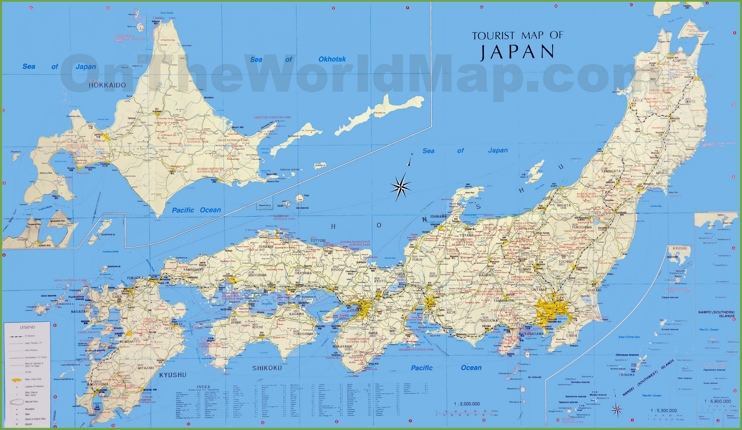
You may download, print or use the above map for educational, personal and non-commercial purposes. Attribution is required. For any website, blog, scientific research or e-book, you must place a hyperlink (to this page) with an attribution next to the image used.
Maps of Japan
Cities of Japan
- North America Map
- South America Map
- Oceania Map
Popular Maps
- Australia Map
- Germany Map
- Singapore Map
- United Arab Emirates Map
- United Kingdom Map
- United States Map
- New York City Map
- Los Angeles Map
U.S. States
- California Map
- Colorado Map
- Florida Map
- Georgia Map
- Illinois Map
- New York Map
- North Carolina Map
- Virginia Map
Itinerary Ideas
Nationwide itineraries.
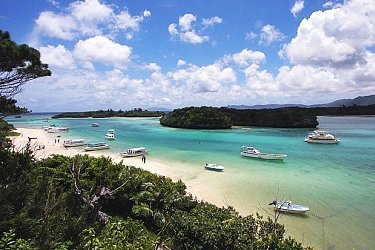

Regional Itineraries
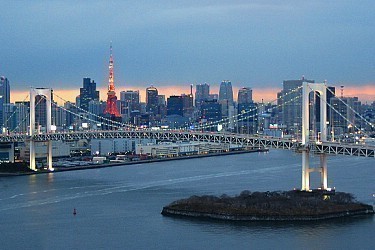
Local Itineraries
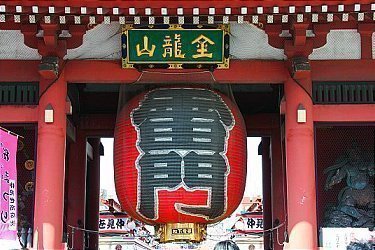
Questions? Ask in our forum .

- For Media & Travel Trade

- About Kyoto
- Arts & Crafts
- Town & Architecture
- Temples & Shrines
- Eat & Drink
- Festivals & Events
- Accommodations
- Activities & Experiences
- Sustainable Activities
- Morning & Nightlife
- Itineraries
- Families with kids
- Travel Tips
- Destination Index

By using this site, you agree to the use of cookies. See our privacy policy for more information. This site uses machine translation, so content is not always accurate. Please note that translated content may differ from the original English page.
Kyoto Map (for Tourists)

Kyoto Map powered by Stroly (Free)
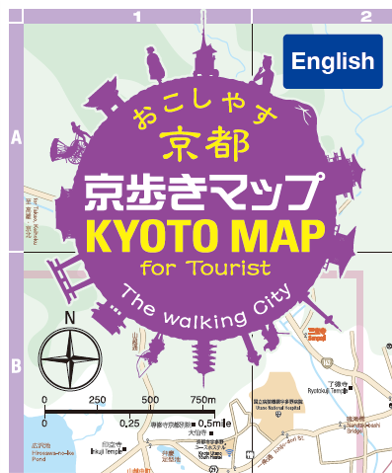
Printable Kyoto Map


Map of the country Japan
You can find on this page the Japan map to print and to download in PDF. The Japan offline map and the detailed map of Japan present the North and the South of Japan in Asia.

The Japan map shows the map of Japan offline. This map of Japan will allow you to orient yourself in Japan in Asia. The Japan map is downloadable in PDF, printable and free.
Japan, island country lying off the east coast of Asia as you can see in Japan map. It consists of a great string of islands in a northeast-southwest arc that stretches for approximately 1,500 miles (2,400 km) through the western North Pacific Ocean. Nearly the entire land area is taken up by the country’s four main islands; from north to south these are Hokkaido (Hokkaidō), Honshu (Honshū), Shikoku, and Kyushu (Kyūshū).
Japan is the only country in the world with a reigning emperor as its shown in Japan map. Emperors have no real power, but they are still revered as a symbol of the country traditions and unity. World War II devastated Japan economy. But the Japanese people hard work and clever innovation turned it around, making it the second largest economy in the world. Japan high-tech industry makes some of the most popular electronic products in the world.
Japan has become a world leader in research on causes and prediction of earthquakes. The development of advanced technology has permitted the construction of skyscrapers even in earthquake-prone areas as its mentioned in Japan map. Extensive civil defense efforts focus on training in protection against earthquakes, in particular against accompanying fire, which represents the greatest danger. Another common hazard are typhoons that reach Japan from the Pacific.
Japan on map
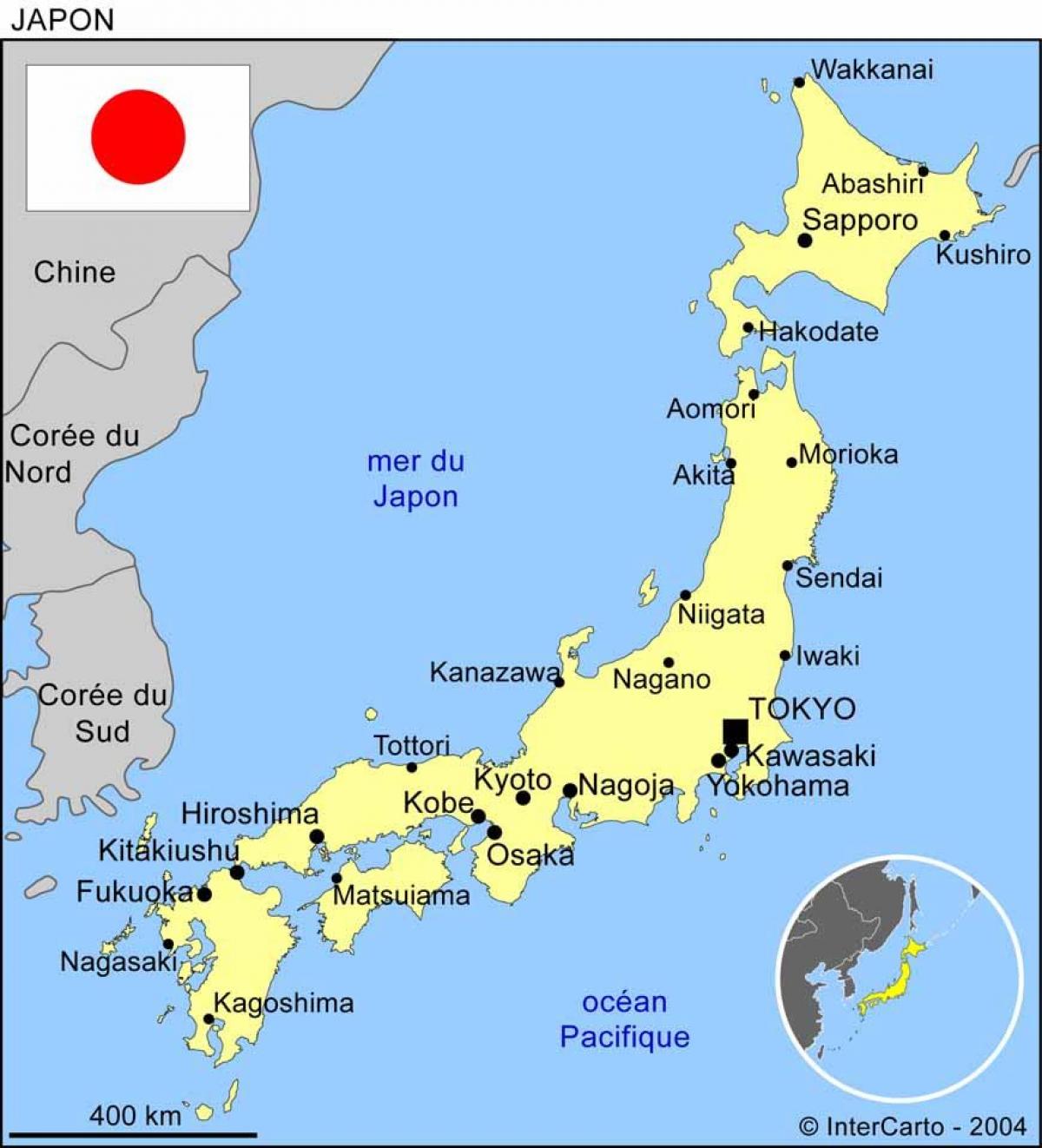
Japan on the map
Japan on map shows the map of the country Japan. Japan on the map will allow you to plan your travel in Japan in Asia. The Japan map labeled is downloadable in PDF, printable and free.
Japan is an archipelago of some 6,852 islands located in a volcanic zone on the Pacific Ring of Fire as you can see in Japan on map. A nearly continuous series of ocean trenches, volcanic arcs and shifting tectonic plates, the Pacific Ring of Fire accounts for more than 75 percent of the world active volcanoes and 90 percent of the world earthquakes.
The population of Japan is about 125,000,000, including approximately two million foreign residents as its mentioned in Japan on map. More than half of the non Japanese population is of Korean descent. The development of Japan was filled with limitless cultural changes throughout the 4 periods and under many rulers and samurai warriors.
Some of the largest enterprises in Japan as you can see in Japan on map include Toyota, Nintendo, NTT DoCoMo, Canon, Honda, Takeda Pharmaceutical, Sony, Panasonic, Toshiba, Sharp, Nippon Steel, Nippon Oil, and Seven & I Holdings Co. It has some of the world's largest banks, and the Tokyo Stock Exchange (known for its Nikkei 225 and Topix indices) stands as the second largest in the world by market capitalization. Japan is home to 326 companies from the Forbes Global 2000 or 16.3 percent (as of 2006).
Detailed map of Japan
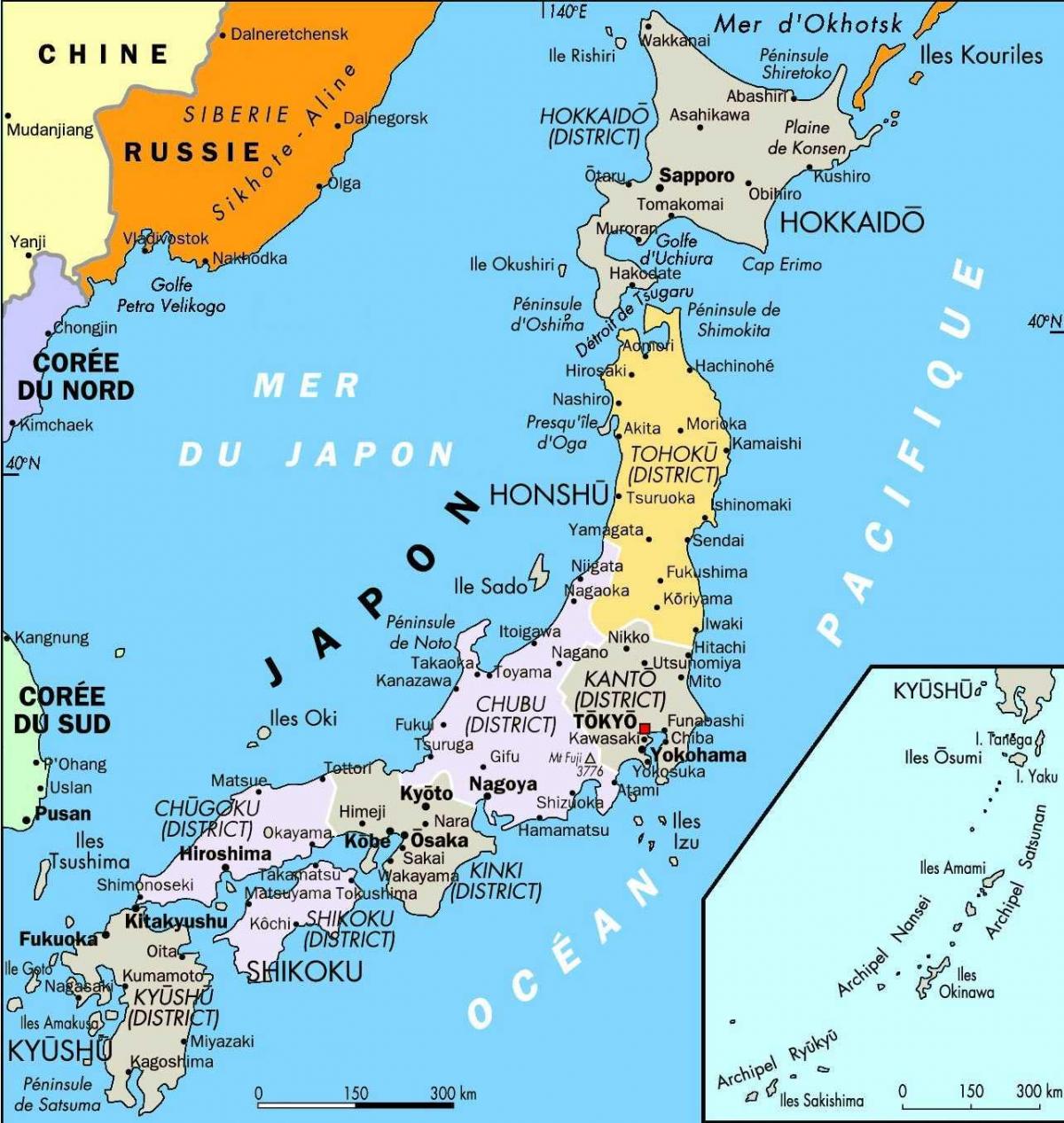
Map of Japan detailed
The detailed map of Japan shows a labeled and large map of the country Japan. This detailed map of Japan will allow you to orient yourself in Japan in Asia. The detailed Japan map is downloadable in PDF, printable and free.
The Japanese archipelago stretches over 3,000 kilometers from north to south, and encompasses 47 prefectures with Tokyo located near the center as you can see in the detailed map of Japan. There is more to Japan than just Tokyo: The northern island of Hokkaido, which will be hosting the Olympic marathon and race walking competitions, is known for its cool summers and stunning wilderness. The soaring mountains of central Japan are packed with trails perfect for summer hikes. From dramatic coastal landscapes to the sapphire waters of Okinawa, each prefecture has something unique to offer for the Tokyo 2020 Olympic and Paralympic Games.
Japan area is comparable to that of Germany or California. Japan northernmost islands are located on a similar geographical latitude as Milan or Portland, while her southernmost islands are on a similar latitude as the Bahamas as its shown in the detailed map of Japan. More than 50% of the country is mountainous and covered by forests.
The only part of Japan with antipodes over land are the Ryukyu Islands, though the islands off the western coast of Kyūshū are close. The northernmost antipodal island in the Ryukyu Island chain, Nakanoshima, is opposite the Brazilian coast near Capão da Canoa as its mentioned in the detailed map of Japan. The other islands south to the Straights of Okinawa correspond to southern Brazil, with Gaja Island being opposite the outskirts of Santo Antônio da Patrulha, Takarajima with Jua, Amami Ōshima covering the villages of Carasinho and Fazenda Pae João, Ginoza, Okinawa with Palmas, Paraná, the Kerama Islands with Pato Branco, Tonaki Island with São Lourenço do Oeste, and Kume Island corresponding to Palma Sola. The main Daitō Islands correspond to near Guaratuba, with Oki Daitō Island near Apiaí.
Map of Northern Japan
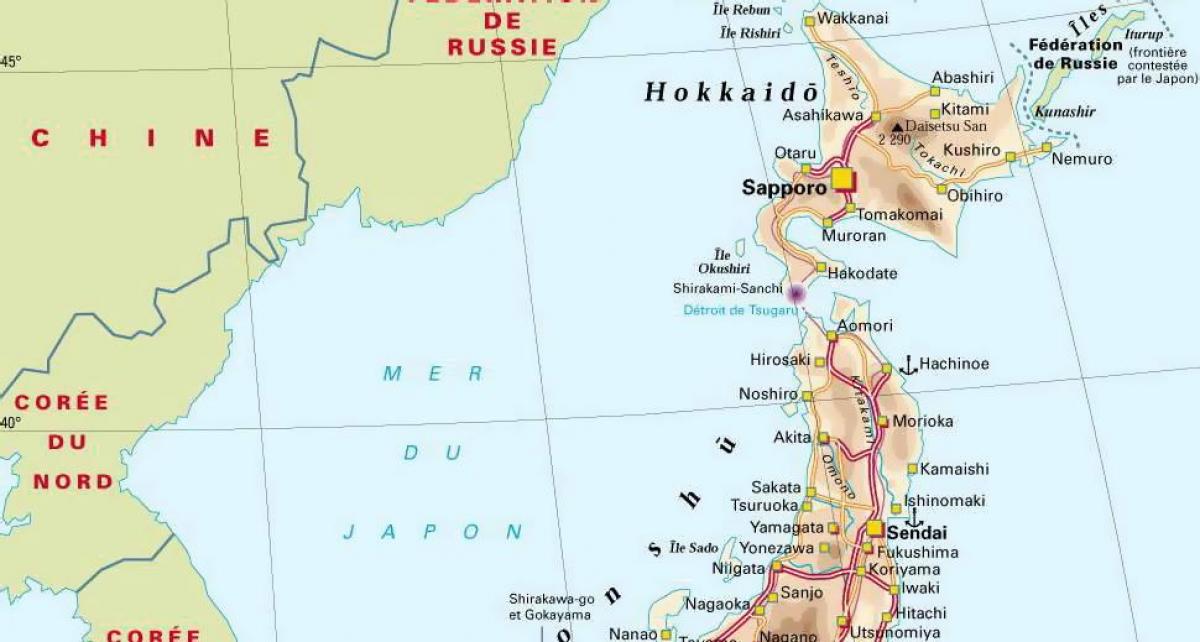
Map of North Japan
Map of Northern Japan shows the North part of the country Japan. Northern Japan map will allow you to easily explore areas of the North of Japan in Asia. The map of Northern Japan is downloadable in PDF, printable and free.
The vast expanse of the Tōhoku region – the northern half of the largest Japanese island, Honshū – is left off most travellers itineraries as you can see in the map of Northern Japan. But it is a rewarding area to visit, not only because of its natural beauty and cultural riches, but because parts of the region are still struggling to boost visitor numbers after the 2011 earthquake and tsunami.
The regions of Japan to the northeast of Tokyo are more sparsely inhabited and less often visited by tourists, either foreign or Japanese. Yet northern Honshu – which is more commonly known as ‘Tohoku’ – and the northernmost island of Hokkaido offer the advantage of unspoiled countryside and friendly down-to-earth villagers still imbued with something of a frontier spirit (see the map of Northern Japan). Much of the Pacific coast of Tohuku was devastated in the 2011 tsunami and will take years to recover.
In the far north, only 25 miles from Hokkaido, the Shimokita Hantō is home to the eerie landscapes of Mount Osore, where the souls of the dead are said to wander, and the intriguing rock formations of Hotokegaura as its mentioned in the map of Northern Japan. Furthest north of all is Aomori, which is a friendly and down-to-earth port city. Visit for its delicious fresh fish, lively waterfront and several excellent museums.
Map of Southern Japan
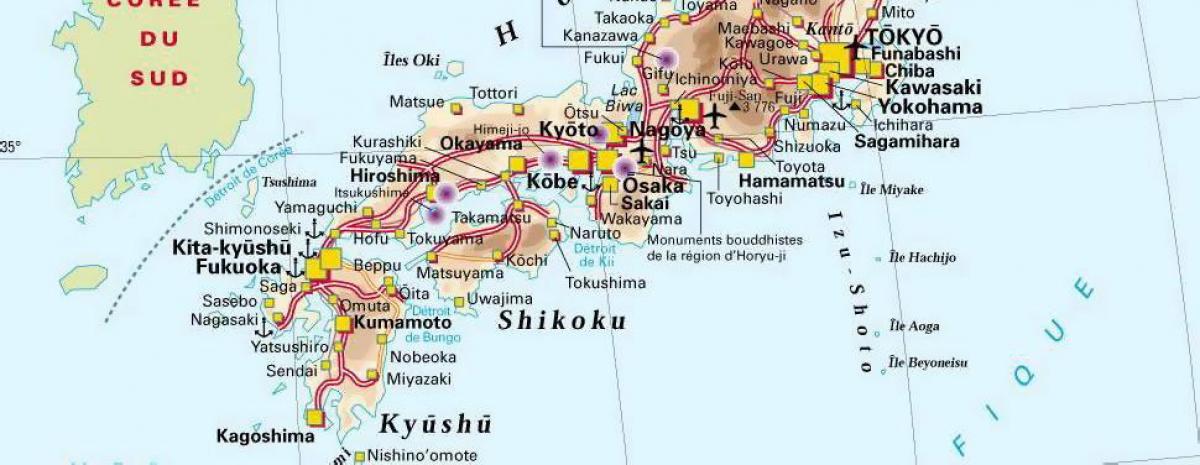
Map of South Japan
Map of Southern Japan shows the South part of the country Japan. Southern Japan map will allow you to easily explore areas of the South of Japan in Asia. The map of Southern Japan is downloadable in PDF, printable and free.
Focused on cities like Tokyo and Osaka, many travelers to Japan never venture past the central part of the country as its mentioned in the map of Southern Japan. Yet many sites of historic interest and natural beauty are situated in the southernmost pair of Japan main island. Although infrequently visited, these two islands of southern Japan offer visitors some of Japan best attractions, as well as regional spins of Japanese cuisine.
Southern Japan encompasses the islands of Shikoku and Kyushu, and Chugoku – the western extremity of Honshu as its shown in the map of Southern Japan. Each is quite different yet all have one element in common: Seto Naikai, or the Inland Sea. All three regions also face the open ocean, and as a result, each area has widely varying climates. The area also extends far to the southwest along the subtropical island chain of Nansai-shoto, which includes Okinawa.
Colloquially, the main tourist draw to Shikoku is its 88-temple pilgrimage trail, which has been attracting the faithful—both Buddhists and ecotourists—for centuries (see the map of Southern Japan). Speaking of the Naruto Bridge, which connects Shikoku to Honshu via Awaji Island, just underneath it is where you will find one of southern Japan most fascination natural phenomena: Naruto Whirlpools. Whether you watch an awa-odori dance performance in Tokushima between trips to the Naruto Whirlpools and Iya Valley, scale ancient castles in Kochi and Matsuyama, or traipse around Takamatsu Ritsurin Garden before heading to Kotohira-gu, you’ll vastly increase your Japan travel street cred by getting to know its premier southern cities.
There’s no need to tip in Japan. Here’s what else travelers should know.

The Land of the Rising Sun has fascinated travelers for centuries, and this summer is no exception.
Tokyo is among the top five international cities Americans are visiting this summer, according to Expedia and Google Flights. And with the exchange rate currently so strongly in Americans’ favor, it’s an especially good time to visit if you can take the hot and humid weather .
Before you book your flight though, there are some things you should know. From cultural customs to customs and immigration, here are 10 things to do when visiting Japan.
1. Learn basic Japanese
Some people, particularly in Tokyo, may speak English, but it’s best to learn a few basic phrases in Japanese like “hello,” “excuse me,” “where is the restroom?” and “thank you.” There are free tutorials available across social media and language apps like Duolingo or Babbel.
You’ll also want to download a free translation app like Google Translate that can handle both verbal and written translation.
2. Fill out the Visit Japan Web form
U.S. citizens don’t need a visa to visit Japan for stays under 90 days, but you will need to fill out a Visit Japan Web immigration and customs form . Save time by doing this in advance online instead of at the airport when you arrive.
What to know about Tokyo Disney Resort: Why Disney fans will travel all the way to Japan for its theme parks
3. Get a transit card
A prepaid Suica or PASMO transit card isn’t just for public transportation. It can also be used to pay for things at vending machines, convenience stores and some shops.
You can download a digital version through Apple Wallet or get a physical card once you arrive in Japan. Just keep it loaded with as much money as you want to spend.
4. Keep cash on hand
Cash is still king in some places, including food stalls and small shops that may not accept credit cards or digital payments.
You can withdraw cash for low fees and fair exchange rates from ATMs at Japanese convenience stores like 7-Eleven. A Suica or PASMO card can tide you over until you can get to an ATM.
5. Skip the tip
There’s no tipping culture in Japan. In fact, some servers have been known to follow customers out and return tips like they were accidentally left behind. Instead of tipping at restaurants, offer thanks.
Before eating, it’s customary to say “ itadakimasu ” like a quick prayer to show appreciation for the food and those who grew it. When you leave, you can say “ gochisousama deshita ” to staff to show gratitude for the meal.
6. Stand aside on escalators
In Tokyo, people stand to the left of escalators and keep the right side open for others walking up or down the moving steps. In Kyoto, like in most U.S. cities, people stand on the right. Don’t worry about trying to remember which side to stand on. It will be immediately clear once you’re there. Just do what everyone else is doing and don’t block foot traffic.
7. Keep the noise down on trains
It’s considered rude to talk on your cell phone or play music or videos out loud on subways and trains. You may hear some small groups of friends chatting, but many commuters keep quietly to themselves.
8. Wear or carry socks
Some places, like temples or restaurants with tatami mats, may require you to remove your shoes. If you’re not wearing socks, you may want to carry a clean pair with you, just in case.
9. Prepare to bare all at onsens
If you’re not comfortable sporting your birthday suit around others, you may want to skip public hot springs. Swimsuits and other garments aren’t allowed in the communal water. Some onsens may also bar tattoos or ask guests to cover them up with a patch. However, there are some tattoo-friendly onsens as well as private onsens available.
Additionally, it’s customary to shower before entering the springs to keep the water clean.
10. You’ll have to wait to open some souvenirs
If you plan to load up on Japanese beauty products, snacks and other consumables to take home, you can buy them tax-free at stores like Don Quixote, but they’ll seal them in a bag indicating they were purchased without paying tax. You can’t open the bag until you leave Japan.
Bonus: Eat all the things, including at convenience stores or vending machines
From egg salad sandwiches to fresh onigiri rice balls, there’s so much good, affordable food in Japan. Don’t miss the delicious and cheap treats at Japanese convenience stores like 7-Eleven, Lawson and Family Mart. The same goes for the wide variety of readily available vending machines selling cold and hot drinks, depending on the season.

15 Essential Travel Hacks When Visiting Japan
A sk anybody what's on their travel bucket list, and their response is sure to include "Japan." Thanks to a combination of rich heritage, lush landscapes, and labyrinth cities packed with skyscrapers, temples, and tourist traps alike, the country has soared in popularity, with American Express claiming that the number of bookings has increased by 1,300% since 2019 (via Bloomberg ).
Part of what makes Japan so alluring is that its culture and customs are so distinct and unique to those of other countries. That's also what makes it an overwhelming travel destination, especially for first-time visitors. If you start your journey in a major city like Tokyo, Yokohama, or Osaka, you're instantly immersed in a world of neon lights, bustling crowds, loud noises, a million different smells, and sensory overload.
With so much to see, do, and eat, a trip to Japan really isn't the kind of vacation you can make up as you go along. The last thing you need is to run into an easily avoided stumbling block like a lack of internet or 30 minutes spent figuring out the route to your next destination — which is why you'll want to arrive armed with as much knowledge as possible.
Read more: 28 Bucket List Destinations That Everyone Needs To Experience At Least Once
Get Quick Meals At 7-Eleven
It's tough to walk for longer than 20 seconds without stumbling upon a convenience store in Japan. Also known as conbini, these stores are usually open 24 hours a day and are packed full of affordable tasty treats that will keep you going without the time (and money) it takes to eat at an actual restaurant.
For as cheap as 200 yen ($1.34), you can enjoy the likes of onigiri rice balls, chicken karaage, sandos, oden, and bento boxes. We also recommend picking up taiyaki for a quick sugar boost. Shaped like fish and made of pancake or waffle batter, they're usually filled with red bean paste, custard, and chocolate and make for an endlessly addictive snack.
The most common store is 7-Eleven, which has over 20,000 locations throughout Japan and is miles above its U.S. counterpart in the culinary department. There are also over 15,000 FamilyMarts scattered across the country, but they typically don't offer as much variety.
Get Pocket Wi-Fi
Public Wi-Fi is surprisingly scarce in Japan, which can put you in some tough spots if you get lost mid-metro commute. Fortunately, pocket Wi-Fi exists -- and it is a lifesaver. For as cheap as $5 a day, you can rent a portable device that will allow you to access the internet on the go, even on the train. The majority will allow you to connect multiple devices at the same time and come in a variety of different speeds and GB, with some even offering unlimited data throughout your stay.
If you rent in advance through a website like Ninja WiFi or Japan Wireless , you can pick up the device (also known by the much cuter name of a Wi-Fi Egg) at a designated counter once you've got through customs at airports including Haneda and Narita in Tokyo, Chubu Centrair, Kansai International, Fukuoka, and more. Once you're done, you can just pop it into the returns box at the airport on the way back. Easy.
Buy A JR Pass
Sadly, the JR (Japan Rail) Pass isn't as cheap as it once was. It surged in price by 70% in July 2023 as the yen continued to decline in value against other currencies around the world. However, if your itinerary includes extensive train travel, it's still worth the purchase.
The Japan Rail Pass will allow you to ride the rail to your heart's desire -- including the country's infamous, lightning-speed Shinkansen bullet trains (for a supplementary fee) and the Narita Express. It's more expensive to purchase once in Japan, so we recommend buying yours in advance on the JRailPass website where it costs $340.65 for seven days, $544.45 for 14 days, and $680.35 for 21 days.
If your visit is limited to just one or two cities, such as Tokyo and Osaka or Tokyo and Kyoto, then it probably isn't necessary. For example, a trip between Tokyo and Osaka typically costs $120 each way, which is considerably cheaper than forking out a few hundred dollars for a JR Pass.
Download Train Schedules And Maps
Japan has incredible public transportation. It also happens to be extremely overwhelming if it's your first (or second, or third) time in the country. Tokyo's metro can be especially confusing, with nine different train lines and 180 different stations to navigate. Its roads are even more complex with the majority not even having names, baffling even the city's own taxi drivers.
With that in mind, future-proofing for any situation where you may end up lost in an unknown place is always a good idea. Download or screenshot train schedules ahead of time through the JRailPass website, which offers both interactive and PDF versions of Tokyo, Osaka, and Kyoto's transportation systems. You can also download an offline version of the local area on Google Maps. This will also help if you face the aforementioned pesky issue of scarce public Wi-Fi, or if your portable Wi-Fi runs out of juice midday.
Use Citymapper
If you're visiting Tokyo, Citymapper is a must. Just like it does for multiple other cities across the globe, the award-winning app analyzes public transportation, congestion, and distance to figure out all the different ways you can reach your destination, and precisely how many minutes each option will take.
Whether it's walking, cycling, taxis, metro, or a combination of everything, all you need to do is select your chosen route and follow Citymapper's step-by-step instructions. When we say step-by-step, we mean it. The app's so smart that it will even tell you which exits and entrances to use at each station to make your journey as stress-free as possible. If you miss your stop or don't quite make your train, the app will also take that into account to restrategize your trip ASAP. You'll need to be online to request a new route, but if you check your journey ahead of time, you can save it to your homepage for offline use.
Visit Between January And March
There is no one "best" time to visit Japan, but there is a most convenient time. January to March tends to attract less crowds and will also usually bring the cheapest flights of the year. While it'll almost certainly be cold, you'll skip typhoon season and be in with a chance of seeing Japan in the snow.
If you do choose to visit at this time, just be sure to check the dates of the Lunar New Year (AKA Chinese New Year). This tends to be a public holiday across the region and will see cities across Japan packed with tourists. As it's such a popular time to travel, this will also be the exception to the "January to March is cheaper" rule with hotels and airlines driving up their prices over the holiday. The same is true of the end of March, which marks the beginning of cherry blossom season.
Make Advanced Reservations
There's a lot to enjoy in Japan. The problem is that everybody else wants to enjoy these things, too. Tourist attractions often book up months in advance, and a lot of them don't sell tickets at the gate, which doesn't leave much space for spontaneity for the average tourist visiting Japan .
If you plan on visiting the likes of the Warner Bros. Studio Tour Tokyo - The Making of Harry Potter, Tokyo Disney Resort, Ghibli Park, Shibuya Sky observation deck, Teamlab Planets, or the Studio Ghibli Museum, it's best to sort your tickets sooner rather than later. The Ghibli Museum is especially challenging, with tickets for the next month going on sale at 10 a.m. on the 10th of the month prior.
The same is true of the hotels at Tokyo Disney Resort . With one of the most impressive Disney hotel lineups in the world (including the MiraCosta, a hotel that is actually inside Tokyo DisneySea), rooms are in extremely high demand. These go on sale from 11 a.m. four months before the dates you hope to stay and are bookable through the Tokyo Disney Resort Online Reservations & Tickets website.
Download The Japan Connected-Free Wi-Fi App
If you don't want the responsibility of carrying around and charging pocket Wi-Fi, download the Japan Connected -free Wi-Fi app. Whether you need to double-check directions or just have a quick midday TikTok break, this handy tool will search over 170,000 internet hotspots to find the closest location to you. The majority of these will likely be at a 7-Eleven, where you'll almost always be able to go online.
As if that feature isn't useful enough, the app eliminates the need to fill in the registration forms that typically serve as a barrier before you can access public Wi-Fi. Fill out your name and email once and the app will complete each form on your behalf. While you used to need to be online to find the Internet (which kind of defeats the app's entire purpose), you can now download the offline map to ensure you can always find a connection. Just remember to be careful with what data you enter or share while using any public Wi-Fi network .
Japan has been a "cash is king" country for years, meaning paying with notes and coins is the default over ApplePay and credit cards. This attitude has slipped in recent years, but cash still has a strong grip on the country's residents with only 36% of people preferring cashless payments.
While you should be able to use your card in most major outlets and tourist locations -- such as department stores, malls, theme parks, supermarkets, and even taxis -- a lot of restaurants, cafes, and bars still prefer to be paid in cash. This number will be much higher outside of major cities, and many local restaurants, markets, or temples won't have the facilities to accept card payments even if they want to. Exchanging at least a chunk of your spending money into Japanese yen ahead of time will save you in sticky situations (plus it helps you control your spending, which is always a bonus).
Choose Taxis Over Ubers
Although Uber exists in Japan, it's not as widespread or commonplace as in countries like the United States, Canada, or the United Kingdom. Journeys tend to be more expensive than those taken with local cabs, making the latter the service of choice for locals and tourists alike.
The upside to Uber is, of course, the fact that it's so familiar for many tourists. It's easy to order your taxi and pay via card, and the entire process is in English. However, your cheapest option is to hail taxis on the street, as you won't need to pay a base fare for the pick-up service. It'll say on the front of a car in Japanese if it's occupied. It's also color-coded so tourists can understand. Red means it's taken. Green means it's available. If you do want to pre-book, most locals prefer to use the Go app for journeys anywhere within Japan's 47 prefectures. This works similarly to Uber, except it allows you to pay with both cash and card and will give you a flat rate for journeys to and from the airport.
Purchase A Suica Card
The question isn't so much what a Suica card can do ; what can't it do? This prepaid, contactless card can be repeatedly loaded up with more cash to pay for public transport, including the metro, trains, buses, and taxis. Beyond transportation, Suica is also accepted in many shops, restaurants, cafes, and even vending machines. Just look out for the Suica symbol to know if they do -- and if you can't spot it, it's at least worth asking.
You can purchase your card before arriving in Japan and return it at the end of your trip to recover your 500 yen ($12) deposit. Due to a manufacturing shortage, the sale of new Suica cards is temporarily on hold as of June 2023, but if you're on a temporary visa, you can still purchase a Welcome Suica card. This doesn't require a deposit, doesn't need to be returned, and is valid for 28 days. These can only be purchased inside Japan at locations such as Narita and Haneda airports and will come with a reference paper which you'll need to keep on your person at all times.
Utilize Storage Lockers
For security reasons, storage lockers are a rarity at train stations around the world. Japan is an exception. You'd be hard-pressed to find a major station without coin lockers (which, despite the name, can actually be used with a Suica card, too), and in Tokyo, most stations come equipped with storage facilities.
Baggage storage is one of those things you don't realize you'll need until you desperately need it. These lockers are useful if you only have a few hours before heading to your hotel or next destination and want to stow away your belongings so you can freely explore. They also happen to be extremely cheap, typically costing between $1 and $5. There's usually no problem finding a vacant locker, but if you are struggling, you can download the SPACER app , which will allow you to find and reserve a locker at major stations such as Shinjuku, Osaka, and Shibuya in advance. This is currently only available in Japanese, but there are plans for an English version in the near future.
Avoid National Holidays
Lunar New Year isn't the only holiday worth skipping if you want to avoid the crowds. National holidays bring in huge crowds anywhere, but especially Japan, where workers get little annual leave and want to take advantage of the break. If you do decide to brave big attractions like Shibuya Crossing, Senso-ji Temple, or Tokyo Skytree, you'll likely find yourself shoulder-to-shoulder with fellow tourists.
For a quieter vacation, April 29 to May 6 -- or, Golden Week -- is one of Japan's busiest holiday periods. This tends to be the most hectic season for the likes of Tokyo Disney Resort and Universal Studios Japan, where you can expect to wait in long lines for everything, from the park entrance to the restrooms. While Christmas isn't a national holiday in Japan, it is for many other countries, meaning the festive season can also bring an influx of tourists to both of these locations. Late September (Silver Week), New Year, and the Obon Week in August are typically also very busy.
Claim Your Tax Refund
From clothes to gadgets, Japan is one of the most unique places for retail therapy in the world. If you're a tourist, you can also shop with the peace of mind that you'll get at least some of your money back. Any non-resident visiting Japan for less than six months can enjoy tax-free shopping, meaning you can reclaim 10% of the value of your purchase.
There are a few catches. First, you'll need to check that the store is in fact a "tax-free shop" by checking for a logo stating as such at the entrance. They're extremely common and can be found in the likes of Namba City, Echika Ikebukuro, and Seibu Shibuya. You'll also need to have spent more than 5,000 yen ($33) in the same store on the same day. Some stores will let you pay tax-free from the offset if you present your passport, while others will require you to present your receipt at a tax exemption counter on the same day to get your money back.
Download A Good Translation App
If you know Japanese, you're good to go. For those of us who aren't bilingual, Japan can be tough to navigate at times. While most signs in major cities will have translations, less than 30% of people living in Japan speak English, which means it's inevitable you'll hit the language barrier at some point during your stay.
A good translation app is a must, especially one that's able to translate pictures. Google Translate is always a go-to, but one of the best choices is iTranslate Translator . Not only can it tackle text, but you can also use it to scan and translate menus, signs, labels ... you name it. Best of all, it can work offline if you download the Japanese pack ahead of time. It's free to download but will cost you $5.99 a month to unlock its full potential. Considering how useful it is, it's better to spend $5.99 than find yourself stranded in a restaurant blind-ordering a dish because you can't read the menu.
Read the original article on Explore .
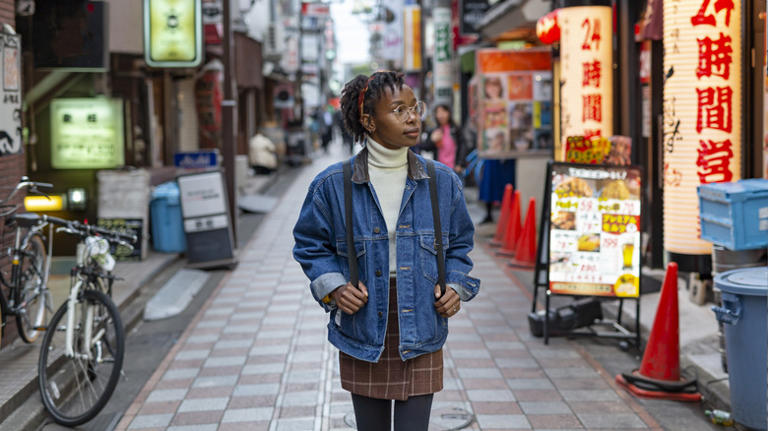
- Tours & Experiences
- Tailor-made Trips
- Bahasa Indonesia
We are happy to see you again!
Continue with
Or use email.
No Account? Create one
Create account
Already have an account? Sign in
Quickly Sign up with
I agree to Japan Travel's Terms of Service and Privacy Policy . Terms of--> and acknowledge that Japan Travel's Privacy--> applies to me.-->
Email reset password link
Please check your inbox and click the link we will send to you.
Where do you want to go?
Let us know how we can help.
Japan’s tourism is a victim of its own success
Faced with the arrival of 33 million travelers taking advantage of the weak yen, the country is taking measures to curb visitor numbers.
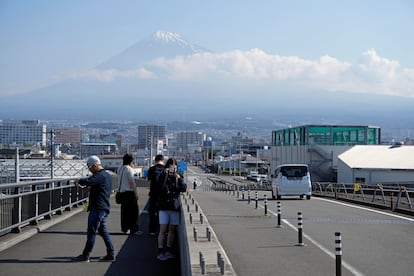
In a far cry from the isolationist Samurai era, the Land of the Rising Sun has become a victim of its own success when it comes to receiving visitors. A destination that was once considered off the map for the majority of tourists due to its remoteness and the language barrier, Japan has managed to multiply its tourist figures in 2023, making a quantum leap from three to 25 million tourists compared to 2022, according to data from the Japan National Tourism Organization (JNTO). And this tourist tsunami is expected to become even more overwhelming in 2024: the country has already welcomed around 12 million visitors and expects this figure to reach 33 million by December, surpassing 2019′s record of 32 million.
Admiring views of Mount Fuji through the mist or taking a selfie in Kyoto’s geisha district are among the country’s top tourist attractions. Now, however, if visitors try to take the iconic roadside photo of the mountain, their view will be obscured by 1.8-meter fencing that was recently installed by the Ministry of Transportation and Tourism to prevent the flood of visitors to the mountain village of Kawaguchi from collapsing the road. Now, if they want to climb the mountain, they have to pay a tax of 2,000 yen (€11.78 or $12.64).
The sudden uptick in tourist numbers is undoubtedly a consequence of the strategy announced by Japanese Prime Minister Fumio Kishida to push tourist numbers to 60 million annual visitors by 2030. Although more than half the arrivals to Japan have been from other Asian countries, the most considerable increase has been from Mexico, up 104% from before the pandemic, followed by U.S. travelers (47.3%) and Middle Eastern visitors (44.6%), according to the JNTO. The influx of tourists, bolstered by an attractive dollar-yen exchange rate, contributed 5.3 trillion yen (€31.4 billion or $33.7 billion) to the Japanese economy in 2023. In May, the yen hit its lowest level since 1990, at 160 to the dollar, following the Bank of Japan’s historic reversal of its negative interest rate policy in March.
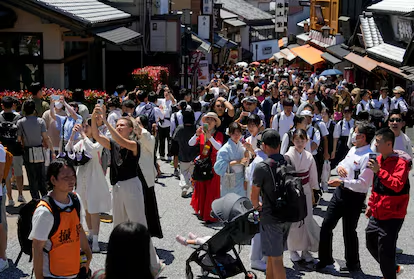
Despite the success of the Prime Minister’s tourist strategy, local areas, burdened by labor shortages, have begun to experience the hidden cost of mass tourism. More than half of Japanese companies say they do not have enough employees, according to a recent survey by Teikoku Databank, a credit research firm. The lack of staff has led to a record number of corporate bankruptcies: 1,016 bankruptcies were recorded in May, with the service and transportation sectors among the hardest hit.
New measures
Famous for its omotenashi or hospitality culture, Japan has had to take sweeping measures, targeting tourism everywhere from Tokyo to the most remote islands. In Shibuya, for example, the capital’s trending district, the authorities have curbed nightlife due to noise and bad behavior. Japan’s islands have also begun to feel the aftershocks of this tourist boom . The surge of foreigners to some remote islands in the Okinawa region has prompted several local governments to impose an entry tax on travelers. Miyajima Island, off the coast of Japan, began to charge 100 yen (€0.59 or $0.63) to foreigners arriving by boat to visit Itsukushima Shrine last October. This may seem negligible, but the local government expects to earn 250 million yen (€1.4 million or $1.5 million) from the fee this year, according to the Japanese media.
Sign up for our weekly newsletter to get more English-language news coverage from EL PAÍS USA Edition
More information

29 tourist deaths trigger alarm bells in Medellín

Lisbon, a city dying from its own success
- Francés online
- Inglés online
- Italiano online
- Alemán online
- Crucigramas & Juegos

We use cookies on this site to enhance your user experience. If you continue to browse you accept the use of cookies on our site. See our Cookie Policy for more information.
- Media & PR
- Meetings & Events
- School Groups
- Travel Trade
- Select Language 简体中文 繁體中文(香港) 繁體中文(臺灣) India (English) Bahasa Indonesia 한국어 ภาษาไทย Tiếng Việt Singapore (English) Philippines (English) Malaysia (English) Australia/New Zealand (English) Français Deutsch Italiano Español United Kingdom (English) Nordic countries(English) Canada (English) Canada (Français) United States (English) Mexico (español) Português العربية Japan(日本語) Global (English)
- India (English)
- Bahasa Indonesia
- Singapore (English)
- Philippines (English)
- Malaysia (English)
- Australia/New Zealand (English)
- United Kingdom (English)
- Nordic countries(English)
- Canada (English)
- Canada (Français)
- United States (English)
- Mexico (español)
- Global (English)
- Fujiyoshida
- Shimonoseki
- Ishigaki Island
- Miyako Island
- Kerama Island
- Tokyo Island
- Koka & Shigaraki
- Hida Takayama
- Ginza, Nihonbashi
- Beppu & Yufuin (Onsen)
- Ginzan Onsen
- Nagasaki Islands

- Kumano Kodo
- Shikoku Karst
- Amami Oshima
- Hachimantai
- Omihachiman
- Aizuwakamatsu

- Diving in Japan
- Skiing in Japan
- Seasonal Flowers in Japan
- Sustainable Outdoors
- Off the Beaten Track in Japan
- Scenic Spots
- World Heritage
- Home Stays & Farm Stays

- Japanese Gardens
- Japanese Crafts
- Temple Stays
- Heritage Stays
- Festivals and Events
- Theater in Japan
- Japanese Tea Ceremony
- Cultural Experiences in Japan
- Culture in Japan

- Local Cuisine Eastern Japan
- Local Cuisine Western Japan
- Local Street Food
- Japan's Local Ekiben
- Japanese Whisky
- Vegetarian and Vegan Guide
- Sushi in Japan Guide
- Japanese Sake Breweries

- Art Museums
- Architecture
- Performing Arts
- Art Festivals
- Japanese Anime and Comics
- Japanese Ceramics
- Local Crafts

- Scenic Night Views
- Natural Wonders
- Theme Parks
- Samurai & Ninja
- Iconic Architecture

- Wellness Travel in Japan
- Japanese Ryokan Guide
- A Guide to Stargazing in Japan
- Relaxation in Japan
- Forest Bathing (Shinrin-yoku)

- Experiences in Japan
- Enjoy my Japan
- National Parks
- Japan's Local Treasures
- Japan Heritage
- Snow Like No Other
- Wonder Around Japan

- Visa Information
- Getting to Japan
- Airport Access
- COVID-19 Practical Information
- Anime Tourism
- Countryside Stays
- Sustainable Travel
- Accommodation
- Sample Itineraries
- Travel Agents
- Deals and Tours

- Traveling by Rail
- How to Travel by Train and Bus
- JR Rail Passes
- Train Passes and Discounted Tickets
- Scenic Railways
- Renting a Car
- Yokohama Cruise Port Access
- Travel Brochures
- Useful Apps
- Accommodation Types
- Online Reservation Sites
- Eco-friendly Accommodation
- Luxury Accommodations
- Traveling With a Disability
- Hands-free Travel
- How to Book a Certified Tour Guide
- Volunteer Guides
- Tourist Information Center

- Japanese Manners
- Sustainable Travel in Japan
- Spring in Japan
- Summer in Japan
- Autumn in Japan
- Winter in Japan
- Seasonal Attractions
- Monthly Events Calendar
- Cherry Blossom Forecast
- Autumn Leaves Forecast

- Japan Visitor Hotline
- Travel Insurance in Japan
- Japan Safe Travel Information
- Accessibility in Japan
- Vegetarian Guide
- Muslim Travelers
- Safety Tips

- All News & Blog
- Travellers Blog
- Guides to Japan
- Stories of Japan
- The Other Side of Japan
- Media Releases
- JAPAN Monthly Web Magazine

My Favorites
${v.desc | trunc(25)}
Planning a Trip to Japan?
Share your travel photos with us by hashtagging your images with #visitjapanjp
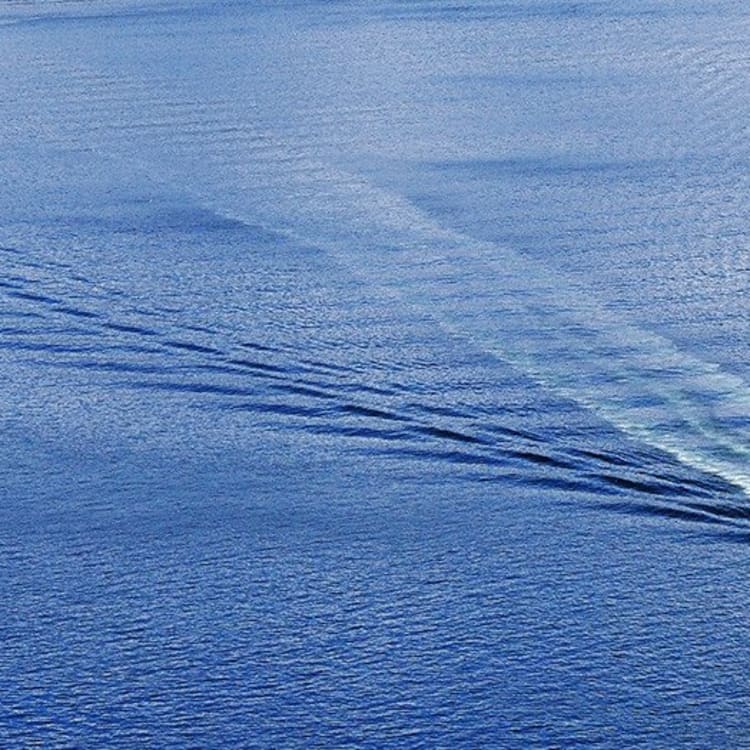
Travel Planner
Here are some useful sites to help with your trip planning:
- Jorudan Japan Transit Planner
- Japan Travel by Navitime
Transport Times & Distances to Major Cities
From Narita Airport (Tokyo)
- To Tokyo station: JR Narita Express train, 55 mins, 23 services daily, 3020 yen
- To Keisei Ueno station: “Skyliner” train, 41 mins, 21 services daily, 2,470 yen (all seats reserved) or Limited Express train, 85 mins, departs every 20mins, 1240 yen
- Airport Limousine Bus: Frequent services to Tokyo City Air Terminal (TCAT), 3000 yen; to Tokyo station, 85 mins; 3100 yen; to major hotels in Tokyo, up to 120 mins, 3100 yen; to Haneda Airport, 65 mins, 3100 yen
From Haneda Airport (Tokyo)
- To Shinagawa station: Keikyu Airport Express train, 20 mins, 410 yen
- To Hamamatsucho station: Tokyo Monorail, 20 mins, 490 yen
From Kansai Airport (Osaka)
- To Kyoto station; 75 mins by JR Haruka train, 3570 yen or 85 mins by bus, 2550 yen
- Osaka station: 65 mins by JR Rapid train, 1190 yen or Airport Limousine Bus, 1550 yen
- Shin-Osaka station: 50 mins by JR Haruka train, 2850 yen
- Tennoji station : 33mins by JR Haruka train, 2230 yen
- Namba station: 35 mins by Nankai Railways “Rapi-t” train, 1430 yen or by Limited Express, 920 yen
- Kobe Sannomiya station: 70 mins by Airport Limousine Bus, 1900 yen
- Nara: 85mins by Airport Limousine Bus, 2050 yen
- Osaka Itami Domestic Airport: 75 mins by bus, 1950 yen
Helpful Sites
- JAL oneworld Yokoso/Visit Japan Fare – Discount domestic air fare for overseas visitors to Japan
- Experience Japan Fare by All Nippon Airways – Discount domestic air fare for overseas visitors to Japan
- Japan Rail Pass – The most economical way to travel throughout Japan by rail
- Welcome to Tokyo Metro – Tokyo Travel Guide, Tokyo Subway Route Map and Ticket Information
Please Choose Your Language
Browse the JNTO site in one of multiple languages

IMAGES
VIDEO
COMMENTS
Japan Travel is your official guide for local info and things to do in Japan. Find hotel, restaurant, and tour information with our Japan map or plan your next Japan trip with our tourism guides.
Japan Map. Search our regional Japan map using keywords and place names, or filter by region below. Where would like to go in Japan? Find the best attractions, hotels, restaurants, and top things to do with our map of Japan. Search and explore the Japan map by city, prefecture, and region.
Kushiro & Hokkaido East. Gion & Higashiyama. Ishigaki Island. Around Fukuoka City. Kiyosato & Hokuto. Naha. Sendai City. Hiroshima City. Check out our Japan map, explore Japan's destinations and travel highlights in this comprehensive guide to where to visit in Japan.
Japan is an island country in East Asia, located in the Pacific Ocean. The Japanese archipelago consists of nearly 7,000 islands, of which the four main ones (Hokkaido, Honshu, Shikoku and Kyushu) represent more than 95% of its territory. Japan is divided in 9 regions from north to south: Hokkaido, Tohoku, Kanto, Chubu, Kansai (also called ...
This travel map of Japan will allow you to easily plan your visits of landmarks of Japan in Asia. The Japan tourist map is downloadable in PDF, printable and free. Japan is a unique blend of traditional and modern, with many temples and buildings from the past co-existing with modern achievements in architecture and technology as its mentioned ...
The official site of Japan National Tourism Organization is your ultimate Japan guide with tourist information for Tokyo, Kyoto, Osaka, Hiroshima, Hokkaido and other top Japan holiday destinations. We offer travel information to make your Japan travel more comfortable and enjoyable.
11. Ishigaki. Located west of Okinawa, Ishigaki is Japan's premier beach destination and makes a good base to explore the other islands in the Yaeyama archipelago. Blessed with Japan's best beaches, it is particularly popular with families since the beaches at Fusaki and Maezato are net-protected.
Our tourist maps The capital of Japan is a must-go to discover the many different aspects of the country. From the trendy boutiques of the Shibuya district to the video games and electronic stores in the Akihabara district, to the calming and relaxing Shinjuku Gyoen National Garden, each district has its own unique atmosphere.
7 Scenic Lighthouses in Japan. Kim. As an island nation, Japan has a significant coastline - and the varied topography including rugged cliffs, intricate bays, an..
Japan Travel App Japan Travel app supports international tourist traveling to Japan with the most efficient navigation. You can find destinations to visit, plan itineraries, make reservations, and search routes while actually traveling. Content is available in 13 languages. Area. Hokkaido / Tohoku. Hokkaido. Aomori. Iwate. Miyagi.
1. Golden Pavilion, Kyoto. The Golden Pavilion is one of Japan's most popular tourist attractions, and it is not difficult to see why. Also known as Kinkaku-ji, this Zen Buddhist temple is situated in Kyoto. It is highly regarded for its stunning architecture.
Japan tourist map. 5488x3179px / 5.82 Mb Go to Map. Japan high speed railway map. 3400x3509px / 1.4 Mb Go to Map. Pictorial Travel map of Japan. 1156x803px / 422 Kb Go to Map. Japan location on the Asia map. 2203x1558px / 616 Kb Go to Map. About Japan. The Facts: Capital: Tokyo. Area: 145,937 sq mi (377,975 sq km).
5. The Island Shrine of Itsukushima, Miyajima The Island Shrine of Itsukushima . Just a short ferry ride from mainland Hiroshima is the island of Miyajima, famous the world over as Japan's Shrine Island.Covering an area of 30 square kilometers in Hiroshima Bay, Miyajima is best known as the home of the Itsukushima Shrine, a Shinto temple dedicated to the Princess daughters of the wind god Susanoo.
Cultural Trip in Japan - 9 Days. Browse our collection of Japan travel maps to find tour & itinerary ideas for your Japan trip. Itineraries include: Guide to Japan's Main Regions, 10 Days in Japan - 5 Unique Itinerary Ideas, 2 Weeks in Japan - 5 Unique Itinerary Ideas, 8 Days in Japan - 5 Unique Itinerary Ideas, and 5 Days in Japan.
Sagamiko Resort Pleasure Forest. Sagamiko Resort Pleasure Forest is located in the beautiful landscape of Sagamihara, Kanagawa, just an hour away from the heart of Tokyo's Shinjuku... Kanagawa ¥1,900. Culture.
Japan tourist map Click to see large Description: This map shows cities, towns, highways, roads, railroads, airports, mountains, points of interest, tourist attractions and sightseeings in Japan.
We strive to keep Japan Guide up-to-date and accurate, and we're always looking for ways to improve. If you have any updates, suggestions, corrections or opinions, please let us know:
Printable Kyoto Map. Use these printable. 1. KYOTO MAP for Tourist (pdf) 2. Kyoto City Map (pdf)
Japan on map shows the map of the country Japan. Japan on the map will allow you to plan your travel in Japan in Asia. The Japan map labeled is downloadable in PDF, printable and free. Japan is an archipelago of some 6,852 islands located in a volcanic zone on the Pacific Ring of Fire as you can see in Japan on map.
2. Fill out the Visit Japan Web form U.S. citizens don't need a visa to visit Japan for stays under 90 days, but you will need to fill out a Visit Japan Web immigration and customs form.Save ...
A sk anybody what's on their travel bucket list, and their response is sure to include "Japan." Thanks to a combination of rich heritage, lush landscapes, and labyrinth cities packed with ...
Explore our Japan map by city, prefecture, and region.
Travel Japan - The Official Japan Guide. None U.S.-JAPAN TOURISM YEAR 2024. None Climbing Mt. Fuji - Things to Know in 2024. None Escaping the Crowds - Uncovering the Charms of Little Kyoto in Japan. None "Open the Treasure of Japan" in 2023 and Beyond. None ...
Receive up to 40% off available accommodation bookings in the US including AK, HI, Puerto Rico, and US Virgin Islands and bookings for international travel. Discount is applied to price of room before taxes and any fees, including additional fees collected by the property at check-in. Reservations can only be made up to eleven months in advance ...
A destination that was once considered off the map for the majority of tourists due to its remoteness and the language barrier, Japan has managed to multiply its tourist figures in 2023, making a quantum leap from three to 25 million tourists compared to 2022, according to data from the Japan National Tourism Organization (JNTO).
Japan Brochures and Guides for Travel - Japan National Tourism Organization. Below, you can view and download PDFs of selected brochures recommended for travellers from Australia and New Zealand. For PDF maps and brochures for other parts of Japan, made by JNTO and by our partners, view our digital brochure library.
An international roaming outage is leaving customers of the three major US mobile carriers in the dark, making it difficult or impossible for American customers who are currently out of the ...
To Kyoto station; 75 mins by JR Haruka train, 3570 yen or 85 mins by bus, 2550 yen. Osaka station: 65 mins by JR Rapid train, 1190 yen or Airport Limousine Bus, 1550 yen. Shin-Osaka station: 50 mins by JR Haruka train, 2850 yen. Tennoji station : 33mins by JR Haruka train, 2230 yen. Namba station: 35 mins by Nankai Railways "Rapi-t" train ...